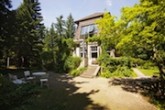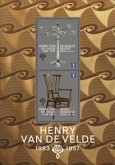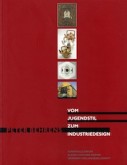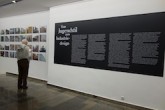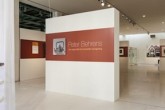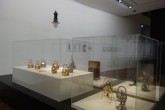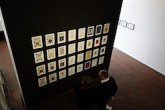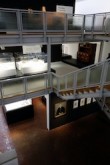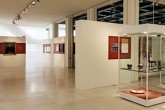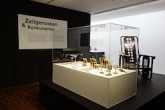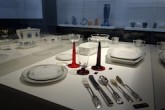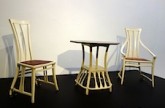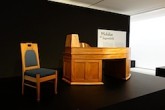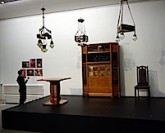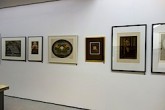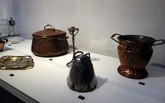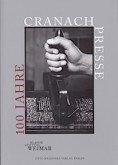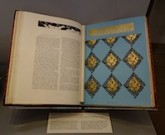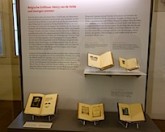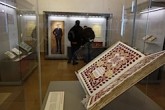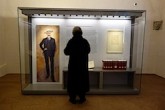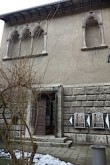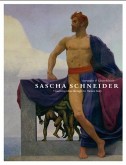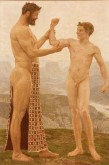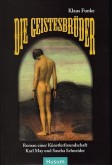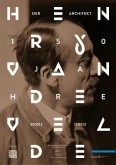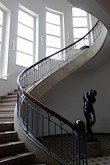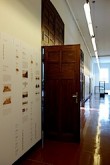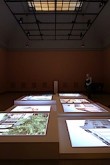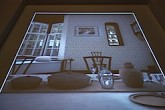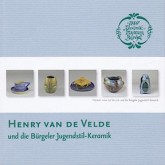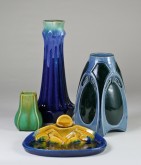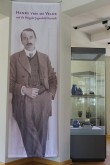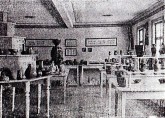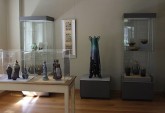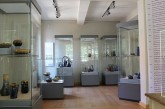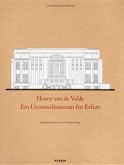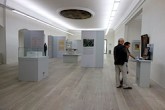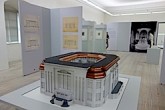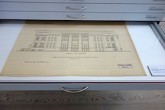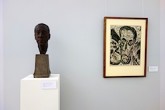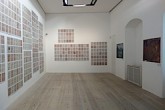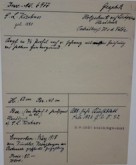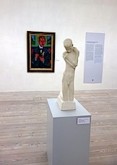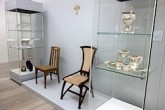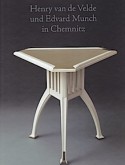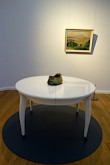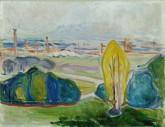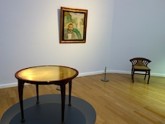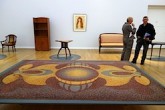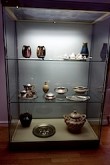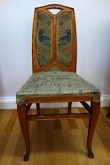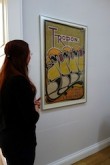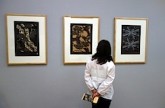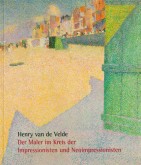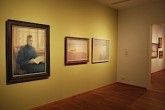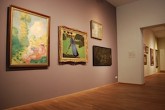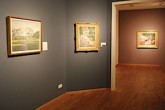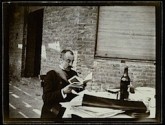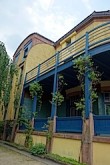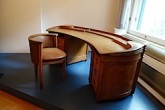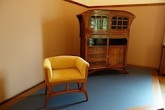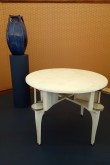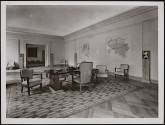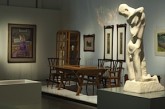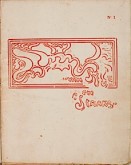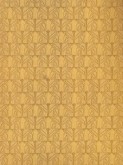The browser will either open the file, download it, or display a dialog.
Henry van de Velde Year 2013 in Germany and Belgium: Part Two
During the summer of 2012, the Klassik Stiftung Weimar acquired Hohe Pappeln (1907–8), the second of four houses built by the Belgian architect and designer Henry van de Velde for his family. After years of cooperating with various owners, then renting the property on the outskirts of the city, the Klassik Stiftung Weimar was able to purchase the historic residence with the support of the Ilse Burghardt Foundation. Hohe Pappeln was given its name by Thyl, van de Velde’s only son. He and his twin sister Thylla were four years old in 1908 when they moved with their parents and three older sisters into the “house under the tall poplars”; the voices of the five van de Velde children still seem to echo in the garden (fig. 1). Visitors to the major van de Velde exhibition held in Weimar from March 24 through June 23, 2013, could buy a combination ticket permitting a tour of the house, and a gala celebration took place there on April 3, 2013, the artist’s 150th birthday.[1] After the main exhibition closed in June, museum goers seeing other anniversary shows in Thuringia and Saxony could still stop in Weimar to visit both the Nietzsche Archiv, remodeled by van de Velde in 1902–03, and his exquisite country house Hohe Pappeln.
The Weimar exhibition traveled to Brussels for a second venue under the title, Henry van de Velde: Passion, Function, Beauty. On view from September 13, 2013, through January 12, 2014, the show included supplementary loans, among them a mahogany desk (1934–35) commissioned from van de Velde by King Leopold III. The exhibition marked the first public display of the royal office ensemble, including the desk and its accessories, a chart table, a chair, and a carpet; also on view was the monumental painting by Henri Leys, The Founding of the Order of the Golden Fleece (1862), for which van de Velde designed a frame. The Cinquantenaire could not, however, offer a combination ticket to visit Bloemenwerf, the Belgian’s first house and initial project as an architect, built in 1895–96 some five miles away in the commune of Uccle. If determined art lovers located the house at Vanderaeylaan, No. 118, they could see only trees and a distinctive wrought iron gate, unless they had an appointment with a real estate agent. Midway through Van de Velde Year 2013, the current owner put Bloemenwerf and its garden up for sale for €2.45 million (reduced to €2.25 million by October).
Three excellent essays in the 2013 Weimar and Brussels exhibition catalogues stress the importance of the van de Velde dwelling in Uccle as a key to the “new style.”[2] Rooms on both floors surround a central skylit hall, a plan based on function and beauty and executed with passion. Living space adjoined studio, works of European and Japanese art hung near furniture made in the novice architect’s own workshops. The structure itself was in harmony with the garden designed by Maria Sèthe, who married van de Velde in the spring of 1894. Every component of the house and its decoration emerged from the couple’s vision of their refuge and the work they hoped to accomplish there. Before the turn of the twentieth century, Julius Meier-Graefe, Siegfried Bing, and other visitors had recognized Bloemenwerf as a cradle of art nouveau. But once the van de Veldes moved to Berlin in late1900, the interior became all but inaccessible. Critics forgot the novel plan and dismissed the exterior as a transplanted English cottage. The building and garden, classified in 1983, were included in the proposed list Belgium submitted in 2008 to the UNESCO World Monuments List. Yet even if the extant architectural works of van de Velde were nominated and inscribed on the list, as were four surviving buildings in Brussels by Victor Horta in 2000, that recognition would not necessarily attract enough financial support to maintain the property or develop an appropriate use.
Brussels is not the only city to have allowed changing tastes and financial greed to destroy its art nouveau heritage, but it is perhaps the only one with its own word, in several languages – Brusselization – to describe the act of tearing down important structures to erect insignificant ones. The city achieved this distinction in 1965 by demolishing, in the face of international protests by hundreds of architects, Victor Horta’s Maison du Peuple. The remains of the building languished in vacant lots to be picked over for scrap; a few elements, rescued by a brewery, can be seen in the Art Nouveau Room above the Grand Café Horta in Antwerp. Portions of the façade of another indispensable Horta building – the Hôtel Aubecq, torn down in 1950 – were hauled from one vacant lot to another throughout the country before returning to Brussels to be provisionally reassembled in a prone position on the floor of a warehouse: a façade gisante.
Neither of van de Velde’s residences in Brussels has undergone the dramatic indignities and salvage campaigns of Horta’s buildings. The third house van de Velde erected for his family was in Holland; it was a modified pre-fabricated house called De Tent (1921) that has not survived. His fourth and last self-designed residence, however, La Nouvelle Maison (1927), still stands in the Brussels suburb of Tervuren.[3] In 2003, the Tervuren house appeared on a postage stamp drawn by the brilliant Belgian comic book artist François Schuiten. The Belgian postal service, now called bpost, rose to the occasion of the 150th anniversary year by commissioning two stamps from Schuiten’s slightly older Flemish contemporary, the well-known book designer and typographer Gert Dooreman (fig. 2). The issue date was September 13, 2013 – opening day of Passion, Function, Beauty in Brussels – and both stamps relate to Belgian museum objects. The candelabra on the first stamp was one of a pair astutely purchased by the Cinquantenaire Museum from the Salon de la Libre Esthétique in 1900; two other examples of this model occupied a prominent place under a Maurice Denis painting in the dining room of Count Harry Kessler’s apartment in Weimar, installed by van de Velde in 1903.[4] Dooreman’s second stamp depicts an armchair from Bloemenwerf now in the collections of the Design Museum Ghent.[5]
Van de Velde treasured his earliest furniture – as do present-day collectors – and took as much of it with him as he could when he moved. Bloemenwerf chairs thus traveled with the artist to Berlin, Weimar, Wassenaar (near The Hague), Tervuren, and Oberägeri (Switzerland). The original Bloemenwerf dining room set – a table, eight chairs, two armchairs, and a matching high chair – remained in Zurich and is part of the van de Velde legacy in the Museum für Gestaltung. The chair now in Ghent depicted on the €3 commemorative stamp and the other dining room furniture from Bloemenwerf displayed in Weimar, Brussels, and elsewhere in 2013 may draw attention to the urgency of preserving the house for which the young designer created those objects.
At the end of the anniversary year, the picture is not entirely bleak. If the energetic cooperation among public cultural managers, sponsors, curators, conservators, scholars, archivists, librarians, exhibition designers, photographers, and private collectors that enriched more than a dozen exhibitions in 2013 could be harnessed to secure stable support for Bloemenwerf and other surviving works by van de Velde, the sesquicentennial would have boosted efforts to preserve his legacy. Weimar’s ongoing project to produce a six-volume catalogue raisonné of his work in interior design and the decorative arts and its editor Thomas Föhl’s continuing labor on the van de Velde correspondence promise a secure foundation for research on the Belgian artist.
Föhl, the reigning van de Velde authority, was co-curator for the last of the five anniversary shows listed in the earlier review in this journal (Autumn 2013). Having brought into focus for a broad public the somewhat vague memory of van de Velde and his wide-ranging accomplishments, Föhl also served as co-curator for Peter Behrens, the first of nine exhibitions described below in the order of their opening dates. Other curators and essayists also turned to van de Velde’s contemporaries: the collector and bibliophile Count Harry Kessler, the Weimar art school professor Sascha Schneider, and the Norwegian painter Edvard Munch and his work in Chemnitz. These investigations may seem at first remotely connected to the Belgian designer. In fact, close study of these four fascinating figures usefully casts van de Velde in a raking light.
Four other exhibitions dealt with van de Velde’s architecture, built and unbuilt, and his mandate to foster the crafts in Thuringia. Finally, after an exhibition in the spring of 2013 exploring van de Velde’s connections with Jena, the city art collections offered a second anniversary show in September. Van de Velde Year 2013 ended in Jena with a look at the colorful circle of the Impressionists and Neo-Impressionists who influenced the Belgian artist so profoundly in his early period. Their works surrounded those made by van de Velde before he renounced painting in 1892 to become an “everything artist”: a theoretician and a brilliant practitioner of the applied arts and architecture.
Peter Behrens: Vom Jugendstil zum Industriedesign
Kunsthalle Erfurt, in Haus zum Roten Ochsen
March 24 – June 16, 2013
Peter Behrens: Vom Jugendstil zum Industriedesign / Van Jugendstil tot industriële vormgeving / Du Jugendstil au design industriel / From Jugendstil to Industrial Design
Design Museum Ghent
July 19 – October 27, 2013
Curators: Thomas Föhl, Claus Pese, Martina Fischer
Catalogue:
Peter Behrens: Vom Jugendstil zum Industriedesign.
Edited by Thomas Föhl and Claus Pese. Essays by Sabine Beneke, Tilmann Buddensieg, Swantje Dogunke, Martina Fischer, Ole W. Fischer, Föhl, Silvia Glaser, Christoph Hölz, Jürgen Krause, Carsten Krohn, Bernd Nicolai, Pese, Udo Schröder.
Weimar: Klassik Stiftung Weimar, 2013.
361 pp.; 391 color illustrations, 61 b&w; illustrated list of exhibited works; name and firm index.
ISBN 978-3-86539-686-0
€38
On the same day in late March 2013, the Klassik Stiftung Weimar opened complementary exhibitions, one in Weimar, the other in Erfurt. Weimar, the city of Goethe, Schiller, and the Bauhaus, became for three months the city of Henry van de Velde, who had lived there as an expatriate from 1902 until 1917. Erfurt, the capital of Thuringia and a city at the geographical heart of Germany, offered visitors in 2013 a rare look at a second Alles-Künstler (all-round artist): Peter Behrens (fig. 3). The parallel exhibitions and their impressive catalogues (both with indexes) enabled comparison of two complex personalities and artistic careers.
Van de Velde was five years older and a foot shorter than Behrens. Both grew up in bustling North Sea port cities; Antwerp on the Scheldt and Hamburg on the Elbe were, after Rotterdam, the largest ports in Europe. Both men started out as painters and liked to boast that as architects they were autodidacts.[6] Their first building projects were their own houses, private showrooms for a new Baukunst and a modern art of living. Unlike the van de Veldes, Behrens and his family never occupied his luxurious model house on the Mathildenhöhe in Darmstadt. It was under construction by late 1900, when Henry and Maria van de Velde moved out of Bloemenwerf with their two young daughters to start a new life in Germany.
In 1898, the luxury Berlin journal Pan introduced both men to an elite circle of art lovers. One issue featured an original four-color lithograph by van de Velde, a poster for the protein supplement Tropon.[7] The following issue included an original six-color woodcut by Behrens, The Kiss.[8] As Claus Pese points out in a scrupulously documented catalogue essay on Behrens in Munich from 1889–99, the real breakthrough for the artist came in the last year of that decade (55–6). Behrens and van de Velde exhibited furniture in 1899 in two different Munich shows. More than 2,000 paintings, works on paper, and sculpture were on view in the huge annual exhibition in the Glaspalast, where Behrens displayed in the arts and crafts section a round table set with linens, glasses, and a stoneware dinner service (58).[9] He had shown the table in Darmstadt in June; it apparently arrived too late in Munich to be included in the Glaspalast catalogue. With a revolving ceramic inset in the middle, the table stood on a blue carpet of his design, repeating the curved motif of the lazy Susan, the plate decorations, and his embroidered linen cloth and napkins. Ferdinand Christian Morawe had already written a review of the Glaspalast show for Deutsche Kunst und Dekoration, but the magazine’s editor Georg Fuchs, impressed by the latecomer’s table ensemble, inserted a few sentences praising Behrens in his own lengthy review of the three applied arts galleries in the1899 Munich Secession show.
The Secession show that summer took place in the exhibition building facing the Glyptothek on the Königsplatz, a short walk from the Glaspalast. The “gentleman’s study in oak,” installed by van de Velde in the largest of the three galleries of the applied arts section on the upper floor, marked his first showing in southern Germany. Although the Secession catalogue stated that all works in the room were by van de Velde himself, photographs show a bronze Woodcutter (1898) by Constantin Meunier on a pedestal to the right of a corner stove and, on the wall to its left, a framed color lithograph by Henri de Toulouse-Lautrec, the frontispiece to his portfolio Elles (1896). Another photograph shows the ante-room adjacent to the study. There van de Velde’s jewelry could be examined closely in a free-standing vitrine; on a table beyond it was one of the two six-armed candelabras listed in the Secession catalogue. Fuchs suggested that the display was overly crowded and that the furniture of the “Dutch reformer,” as Fuchs called van de Velde, although attractive in exhibitions in Berlin or Dresden, appeared almost too rational, too “overpoweringly logical” for a Bavarian audience. The critic praised van de Velde’s practicality and consistent application of his theory of the beauty of pure abstract line, but for Fuchs the room’s unity bordered on becoming unpleasant, something like the aesthetic reaction when a good bicycle is called “beautiful.”[10]
Both designers accepted a summons to court from two quite different rulers. Behrens and Joseph Maria Olbrich, who had recently completed the Vienna Secession building, were the most prominent of seven artists engaged by Grand Duke Ernst Ludwig of Hesse to establish an artists’ colony in Darmstadt. Settled in the grand duchy after late 1899, Behrens received the title of professor and fulfilled his contract. His chief project was his extraordinarily costly house on the Mathildenhöhe built in 1901 for the Darmstadt exhibition, Ein Dokument deutscher Kunst (a document of German art). Unable to get along with Olbrich, he left in 1903 to head the Düsseldorf Kunstgewerbeschule. Meanwhile, van de Velde had received an invitation from Grand Duke Wilhelm Ernst of Saxe-Weimar-Eisenach to become his advisor on art and industry. In Weimar, the artist launched his Kunstgewerbliches Seminar to train Thuringian craftsmen, laying the foundations for the future Bauhaus, and received his professor’s title in 1903.
Professors Behrens and van de Velde held teaching posts for most of their lives. Behrens served as mentor for four star architects: Walter Gropius, Mies van der Rohe, Adolf Meyer, and Le Corbusier. Van de Velde’s most famous student was the Finn Sigurd Frosterus, who came to Weimar in 1902–03 after obtaining his diploma as an architect in Helsinki. In addition to sharing important friends and patrons – among them, Julius Meier-Graefe, Count Harry Kessler, Friedrich Deneken, and Karl Ernst Osthaus – Van de Velde and Behrens also shared a pupil, the designer Else Oppler, who had worked under Josef Hoffmann in Vienna as well.[11] Van de Velde illustrated an article on women’s clothing in 1902 with photographs of Oppler modeling her own designs.
The most powerful influence on the two men at the turn of the century, as on countless contemporaries, was Friedrich Nietzsche. Behrens (1902) and van de Velde (1908) both designed versions of Also sprach Zarathustra.[12] Their nearly simultaneous work on Haus Behrens (1901) in Darmstadt and the alterations of the ground floor of the Nietzsche Archiv in Weimar (1902–3) inspired a trenchant comparison by Ole W. Fischer in an essay for the Erfurt catalogue, “At Home with the Supermen?” (92–104).[13] In another excellent catalogue essay dealing with the early interiors of Behrens, Christoph Hölz describes how elements from Behrens’s formidable Darmstadt music room became even grander and more Egyptian in 1902 at the Turin International Exposition for Modern Decorative Arts (66–91). In his sacral Hamburg Vestibule for the German section in Turin, Behrens placed his Zarathustra volume in a reliquary-like vitrine, a shrine within a shrine.[14] The Schiedmayer piano designed for the music room in Haus Behrens – a paradigmatic remnant of the “Zarathustra style” – was quite understandably not included in the show in Erfurt or Ghent.
The exhibition designs for the two venues of the Behrens show offered an interesting contrast. The Erfurt show opened with a panel of handsome color photographs of extant buildings, ranging from the Darmstadt house (1901) to the Linz tobacco factory (1929–35). The photographs were the work of the Berlin architect and writer Carsten Krohn; he tracked down surviving structures in a recent campaign that took him not only to Austria, but as far as Croatia and Russia (fig. 4).[15] Perhaps because the long, narrow entrance gallery was suitable for a flat display wall, the Erfurt show presented the color images of the buildings as an introduction to their designer. The curators may have anticipated that Behrens’s temple of the machine age, the AEG (Allgemeine Elektricitäts-Gesellschaft) Turbine Factory (1908–9) in Berlin-Moabit, would be more familiar and inspiring to their audience than the architect’s face or the well-cut three-piece suits he wears in all his photographs.
In his introductory essay for the exhibition catalogue, Thomas Föhl explained the sequence of the show on several floors in the Kunsthalle Erfurt and its governing arrangement by material. Each visitor received a free bilingual (German and English) booklet with a chronology and a checklist, a necessary tool for navigating the exhibition. The designers for Erfurt – Holzer Kobler Architekturen, Zurich and Berlin – provided a subtle subliminal motif in the wall texts and the booklet. For displays of works chiefly by Behrens (all but five of seventeen numbered areas), the section titles were set in white on a black ground in the artist’s most famous typeface: Behrens Antiqua. For the sections presenting portraits of Behrens and the work of various contemporaries, the titles appeared in black on white panels in a plain sans-serif font.[16]
The Design Museum Ghent installed the show in its spacious white-floored galleries on flexible, free-standing walls, also white, with bittersweet-orange backing at eye level for hanging texts and images (fig. 5). On the entry panel in Ghent was a photograph of a nickel-plated AEG electric water kettle (1909) from the holdings of the Hamburg collector Udo Schröder, whose loans formed the core of the exhibition. In Erfurt, the museum goer stepping down into the first section – “Art & Industry” – encountered arrays of water kettles, fans, heaters, wall clocks, and graphic art designed by Behrens for AEG after 1907 (figs. 6–7).[17] No wall text preceded the small second section on the ground floor in Erfurt entitled “Portraits” (fig. 8). Although a 1913 portrait of the architect by Max Liebermann from the Hamburger Kunsthalle was the frontispiece for the catalogue, the painting was not on view in either venue.[18] The single oil painting by Emil Rudolf Weiss, preceding four graphic images of Behrens from the 1920s, was perhaps a better choice for the show. When he painted Behrens, Weiss was working in Hagen in 1906 on the mosaic apse for the architect’s crematorium; his frontal portrait of Behrens is as hieratic as the central figure of his Hagen mosaic. The Design Museum Ghent found a prime place for the Weiss painting, which was acquired by Osthaus for his Folkwang Museum in Hagen (fig. 9).
Erfurt’s third section – “Crystal-clear aesthetics” – comprised thirty-four glasses by Behrens from the Schröder Collection, the earliest from 1898 and the latest from 1902. This was a period when the artist was under the spell of the crystal as a symbol, using it as a motif in his Darmstadt house, in the vestibule for Turin, and even for his own bookplate. The crystal was also the focus of the Nietzschean musical drama by Georg Fuchs Das Zeichen (The Sign), staged by Behrens for the opening of the Darmstadt Exhibition in 1901. The adjacent fourth section introduced an assemblage representing Behrens’s contemporaries in Vienna (fig. 10). For the fifth and sixth sections on porcelain and ceramics, Swantje Dogunke wrote a fascinating catalogue essay comparing work in clay by Behrens and van de Velde. She describes their plunge into a craft with materials totally new to both of them, their influence from Japanese objects, their parallel searches for forms, their choices and approaches to manufacturers, and their display methods for products (180–211).[19] Both men adapted local stoneware traditions in the Westerwald region of Rheinland-Pfalz, and nearly simultaneously produced porcelain services for different factories: Behrens at Bauscher in Weiden and van de Velde at Meissen. Dogunke concluded that neither artist managed to achieve the renewal in ceramics that may have been a common aim. The superb catalogue illustrations are particularly helpful in allowing the reader to follow her narrative.
Behrens produced his first sets of silverware and porcelain for the Darmstadt exhibition in 1901. One vitrine in the fifth section partially reassembled the dining room table in Haus Behrens with original pieces from the Schröder Collection (fig. 11). As in his modest but successful display in Munich in 1899, the new porcelain plate decorations were repeated on the mosaic floor and even echoed on the plastered ceiling in this extraordinary room. Two chairs and a small table were displayed near a reproduction of the photograph of the dining room from the 1901 catalogue (fig. 12).[20]
The ample seventh section on metalwork, including some elegant bargain cutlery made of tin, was lent by the Schröder Collection, with the Sammlung SAM providing three handsome cases, one made for a set of a dozen ice cream spoons and a scoop.[21] A valuable written supplement to the gorgeous eighth section (“Style & influence”) was Udo Schröder’s catalogue essay on the English and Scottish designers Charles Robert Ashbee (born the same year as van de Velde), Charles Rennie Mackintosh (the same age as Behrens), and Christopher Dresser (a generation older). Three different and equally imaginative toast racks were among the thirty-two splendid objects by Dresser in the vitrines (fig. 13). All thirty-nine objects in section eight, including a page designed by Dresser for Owen Jones’s Grammar of Ornament (1856; Pl. XCVIII), came from the Schröder Collection (116–33).
The spectacular furniture in the ninth section at the Kunsthalle Erfurt required fitting several small stages into the narrative path. Behrens, a theorist of progressive theater, might have enjoyed the mise en scène of his furniture, spotlighting, for example, a writing desk and two chairs (fig. 14). The desk, its chairs, a sewing table, and a few other pieces came from a major commission during the Darmstadt exhibition, perhaps Behrens’s only commission from the show (14–15, 68). Emilie Reif, wife of Georg Reif, a prominent Nuremberg brewer, ordered for her daughter’s dowry (the Reifsche Aussteuer) furniture and a porcelain service in dark green; Behrens’s demonstration model was in gray. A wall text pointed out that Behrens “distanced himself completely from plant motifs” and a “structured linear ornamentation became the distinctive trademark of his design style.” Similarly, van de Velde, whose shock and repulsion in 1901 at the excesses in the Darmstadt exhibition were recorded by Kessler in his diary, vowed during his visit to re-calibrate his own ornament (102–04).[22] Earthenware floor tiles made from Behrens’s designs by Villeroy & Boch in 1903–04 demonstrate this structural evolution. Four handsome sets of assembled tiles were on display in Erfurt and, in one example, even his spirals become geometric.
Several lamps and pieces of furniture designed by Behrens in 1903 for the villa of Alexander Ritter von Wacker in Lindau attest to a splurge of linear design (fig. 15). In an interesting essay on the early interiors, Christoph Hölz traces the contributions of several students in the architect’s master classes at the Bayerisches Gewerbemuseum. Behrens developed their ideas in the Wacker villa (88-91). The tenth section presented the influence on Behrens of Dutch designers (“Models & motivators”), the eleventh and twelfth that of Richard Riemerschmid and van de Velde (“Individualists & all-round artists”). The Belgian was represented by a range of objects, including a selection of fine book bindings and a single Bloemenwerf chair (from the Sammlung SAM). A wall of Behrens table linens and damasks (section thirteen) hung near the floor display of his earthenware tiles.
The fourteenth section (“Books & typography”) consisted of a vitrine of books and a row of posters on the wall. Behrens’s advertisement in 1914 for the Deutsche Werkbund-Ausstellung poster competition in Cologne seemed inspired by Eberhard Encke’s bronze Dioscuri (destroyed in August 1914) crowning the architect’s latest work, the German Embassy in St. Petersburg. Next to Behrens’s mounted torch bearer was the brilliant competing entry from Fritz Hellmuth Ehmcke. A commendable catalogue essay by Jürgen Krause on Behrens and advertising tells the story of the Werkbund contest (250–53). Van de Velde and Behrens served together on the exhibition’s organizing committee in 1914. Osthaus, also an organizer, hired an excursion train so that 400 exhibition visitors could travel from Cologne to Hagen. There they could tour his museum (with a now-destroyed lecture room by Behrens within the van de Velde interior) and his mansion Hohenhof (built by van de Velde), as well as the nearby mayor’s villa by Behrens and Gropius. In the fierce policy quarrel that erupted just before the Werkbund exhibition opened on May 15, 1914, van de Velde supported personal creativity (Individualismus), opposing proponents of standardization (Typisierung) led by Hermann Muthesius. Hermann Obrist, August Endell, and Bruno Taut defended the Belgian staunchly, as did Behrens (“in his somewhat vague manner,” as van de Velde recalled the confrontation in his memoirs; in the digital version, search for pp. 361–3). The leading modern architects of the German-speaking world thus dug their own polemic trenches shortly before World War I broke out.[23]
In the Kunsthalle Erfurt, the sections on painting and graphic arts were the fifteenth and sixteenth chapters of the extensive show. In Ghent they came first, appeasing the eagerness of museum audiences to see The Kiss. Even for many who cannot name the artist, the colored woodcut of 1898 has become an emblem of Jugendstil.[24] In Erfurt, that small sheet from Pan hung unobtrusively in the middle of a row of woodcuts, among them The Storm, translated from an ukiyo-e by Utagawa Hiroshige (fig. 16). In the oval Butterflies on a Water Lily (1896; private collection), Behrens, not yet thirty, was closer to Japan than to Giverny and framed his composition with a swirl of aquatic grass. A laurel wreath encircled his color woodcut tribute to the writer Otto Erich Hartleben (1898; Schröder Collection) to whom Behrens had given The Storm (46). Print lovers were thrilled to note on the lower margin of the woodcut the artist’s penciled inscription to the Hamburg magistrate and collector Gustav Schiefler. Behrens dated his dedication January 3, 1907, almost two years after Hartleben died (46).[25]
Several works in the paintings section were equally thrilling. Two surviving leather allegorical panels displayed in the Turin vestibule in 1902 were lent to the exhibition by the Museum für Kunst und Gewerbe in Hamburg.[26] With them hung two fragmentary wooden panels (1897–98; Prof. Gerhard Diel and Margitta Schapen Collection, Nuthetal), the source, as Föhl explains, for the Turin leather works five years later (16–17, 54). The wooden panels had decorated the apartment in Berlin of the cultural historian Kurt Breysig, who published an article on Haus Behrens in the Darmstadt catalogue in 1901. The seventeenth and final section of the Erfurt show assembled works made by students Behrens taught in his master classes of 1901–02 at the Bayerisches Kunstgewerbemuseum in Nuremberg (fig. 17). More than a dozen objects, many from the Bayerisches Nationalmuseum, had been traced and lovingly arranged in the last vitrine.
The catalogue, unlike the viewing sequence in the Erfurt exhibition, follows more or less chronologically what curator Pese calls the architect’s life journey. An essay by Bernd Nicolai – “Das ganze Behrens” (the whole Behrens) – allows the reader a fair glimpse of major buildings after 1914. With excellent illustrations of his late architectural projects, Nicolai examines the reception and influence of the aging pioneer. The curators wisely made no further attempt to stray beyond the boundaries of the exhibition’s subtitle: From Jugendstil to Industrial Design.
Of the Vienna period only a photograph of the factory for Linz could be seen at the entrance of the show. At the end of 1921, he was appointed to the chair in the Vienna Fine Arts Academy vacant since the death of Otto Wagner in 1918. Hundreds of Viennese still live in public housing projects he designed. Also from this decade and currently under restoration and conversion into a cultural center is the New Synagogue in Žilina, Slovakia, completed in 1929. Five years later, on May 1, 1934, Behrens joined the then-illegal Austrian Nazi party.[27] He had not truly settled in Vienna, preferring to commute by train from Berlin. Called to direct a master class in architecture at the Academy of the Arts in Berlin in 1936, allegedly at Hitler’s request, he left Austria. Behrens died suddenly in February 1940 at age seventy-one in the Hotel Bristol in Berlin.
Thomas Föhl, co-editor of the catalogue, has an agreeable way of acknowledging his predecessors. In his introduction Föhl refers to the last major exhibition on Behrens held in Nuremberg thirty-three years earlier. He also credits the art historian Tilmann Buddensieg, whose determined engagement launched a rediscovery of Behrens in the 1970s. Buddensieg wrote the catalogue introduction to Peter Behrens und Nürnberg (1980), and for the 2013 catalogue he contributes a brief essay on how he became involved with Behrens and modern architecture through challenges from his students in 1968. Mounting an exhibition on Behrens in Erfurt may seem accidental, Föhl writes, since the city had no connection with the architect’s life or work, yet the impulse of Henry van de Velde Year in 2013 was an opportunity not to be missed. It enabled the Klassik Stiftung Weimar to place Behrens (“an outstanding protagonist of the Early Modern”) in a dialogue with the Belgian artist (17). As Föhl suggested, the synchronized exhibitions offered a combined wealth of objects, especially from private collections, unlikely to be reassembled. Visitors to the shows in Weimar and Erfurt – and to modified versions in Brussels and Ghent – could experience a substantial comparative overview of the two prolific “all-round” artists.
Although the innovative designers had much in common, an essential difference was that Behrens was German. Van de Velde had been deeply insulted in Düsseldorf in 1902 when the Kaiser, refusing to look at the Belgian’s works on display, told his retinue: “I don’t want to get seasick.” Behrens, by contrast, had a portrait of the Kaiser on his desk during World War I. The German architect later recalled creating the inscription for the Reichstag building in Berlin with the calligrapher Anna Simons in 1909; it was not mounted, however, until December 1916. That year hundreds of thousands of German lives had been lost in the deadly Battle of the Somme, and under those circumstances, the words Dem deutschen Volke (To the German people) on the parliament had to look German, not Roman. Behrens Antiqua was not appropriate, so Behrens and Simons invented a bastard script merging uncial (old German Gothic) and classical capitals. The words on the architrave survived both the Reichstag fire in 1933 and World War II: only two of the two-foot bronze letters were missing in 1945. But the family of master craftsmen who had cast the sturdy letters had been cruelly persecuted; Ernst Loevy, the last Jewish owner of the foundry S. A. Loevy, was murdered in Auschwitz.[28] Since the beginning of the twenty-first century, the restored Behrens inscription can be read and pondered on the Reichstag façade under the spectacular new dome by another innovator, Sir Norman Foster.
100 Jahre Cranach-Presse: Buchkunst aus Weimar
Herzogin Anna Amalia Bibliothek, Weimar
March 28 – August 10, 2013
Catalogue:
100 Jahre Cranach-Presse: Buchkunst aus Weimar.
Hans Zimmermann, with foreword by Michael Knoche, and contributions by Roland Bärwinkel, Claudia Kleinbub, Johannes Mangei, and Frank Sellinat.
Berlin: Otto Meissner, for Klassik Stiftung Weimar, 2013.
208 pp.; 102 color illustrations; 3 b&w, with folded insert of photographs by Ursula Braune; glossary; name index
ISBN 978-3-87527-121-8 (trade edition)
€24,95
Weimar celebrated another anniversary in 2013: the centennial of the Cranach Press (fig. 18). Founded by Count Harry Kessler in July 1913, the private press had strong ties to England. Kessler launched his project with a Caslon typeface purchased there in 1904, and he hired a consulting printer from the Doves Press, John Henry Mason, to set up his workshop in Weimar. Kessler’s press was the fulfillment of a tenacious dream. A decade earlier, for his exhibition series at the Grand Ducal Museum of Art and Arts and Crafts (1903–06), Kessler had developed a distinctive format for printing checklists, using the local commercial printer R. Wagner.[29] He also contracted Wagner to print the minutes of the founding session of the Deutscher Künstlerbund, a union of progressive artists established in a meeting at his museum in Weimar on December 16, 1903. For a more ambitious publication of 1910–11, Homer’s Odyssey in translation, issued by the Insel Verlag in Leipzig, Kessler had Wagner print both volumes, each with woodcuts by Aristide Maillol. The Wagner firm also printed for Kessler in 1911 the minutes of the committee to erect a Nietzsche monument, a grandiose project with van de Velde as architect; the monument would have adjoined a vast stadium and swimming pool on the southern outskirts of Weimar but had to be abandoned in 1913. Publications designed by Kessler that preceded the establishment of his press and those resulting from his continuing connection with the Insel Verlag in Leipzig were clearly distinguished in the exhibition labels from those with the imprint of his own press.
Thanks to a legacy from the bibliophile Georg Haar, the organizers of the anniversary exhibition at the Herzogin Anna Amalia Bibliothek could choose from an almost complete collection of materials bearing the Cranach Press colophon. The exhibition display included its first product: the prosaic fifth annual report for the Grand Ducal Saxon Arts and Crafts School (1912–1913). The sixth annual report added a red insignia of the school on the cover; the red and black combination became a characteristic of Cranach Press books. For nearly two decades after this modest beginning until the financially strapped Kessler had to liquidate the press in October 1931, he and his small staff produced some of the most remarkable printed works of the twentieth century.
A handsome volume appeared in 2012 listing a selection of the most beautifully designed books published between 1471 and 2010.[30] The editor was Mathieu Lommen, a curator in the Amsterdam University Library’s Special Collections. For the years between 1895 and 1912, Lommen chose ten outstanding publications: Kessler, van de Velde, and Peter Behrens each designed one of those ten. In 1905 Kessler and the typographer Emery Walker worked on the first two volumes of an elegant, but reasonably priced edition of the collected works of Arthur Schopenhauer. The Schopenhauer volumes highlighted among Lommen’s selections were part of a new series of German classics published by Insel Verlag in Leipzig under the series title, “Grand Duke Wilhelm Ernst Edition” (honoring the ruler in Weimar). Insel also published the book Lommen chose for van de Velde, the elaborate 1908 edition of Nietzsche’s Also sprach Zarathustra, on which Kessler had collaborated. The Peter Behrens work selected by Lommen was a sales catalogue: Bogen Lampen Liste No. 4. It was published in Berlin by the Allgemeine Elektricitäts-Gesellschaft in 1909, the year Behrens completed the AEG Turbine Factory. Kessler appeared once again in Lommen’s pantheon of graphic designers. For the year 1929 in the “Avant-garde” section of his book of beautiful books, Lommen recognized Kessler’s collaboration with the stage designer Edward Gordon Craig on a Hamlet translation by Gerhart Hauptmann. An English edition appeared in 1930, and both the German and French versions continue to be hailed as masterpieces of the art of the book (158–65).
Kessler had allegedly owned a hand press as a teenager and read avidly in several languages. He became closely connected with art publishing through his five-year association with the editorial committee of Pan. Already a hesitant patron of Edvard Munch in Berlin, Kessler was twenty-seven in 1895 when the first of the journal’s twenty-one issues appeared; one of his early enthusiasms was the graphic work of the Munich artist Joseph Sattler. A bookplate created by Sattler for Kessler was reproduced in color on a full page in Pan (1:3 [1895], facing page 364). This vaguely Nietzschean youth – the motto reads, und doch (and yet) – illustrated an essay on the ex libris cult by the expert Peter Jessen, director of the Kunstbibliothek in Berlin (10–11, 22). The Anna Amalia library exhibition displayed as the first numbered object its copy of Pan from the Georg Haar collection, open (at least during the first days of the show) to an editorial on book art (fig. 19). On the facing page was a repeated pattern of black and gold diamonds on blue paper. Both the vignette above the text page – men reading copies of a journal unmistakably identified by the head of Pan on each double spread – and the decorative page facing it are signed by Kessler’s protégé Sattler (32–3).[31]
Count Kessler also admired Georges Lemmen, van de Velde’s Belgian colleague in Les XX in Brussels and later at Siegfried Bing’s L’Art Nouveau in Paris. The Anna Amalia library show devoted a vitrine to Lemmen, displaying stamped bookplates and his cover and colophon for Kessler’s travel memoir, Notizen über Mexico (1898), along with Sattler’s blue ex libris (fig. 20).[32] Lemmen created the type face for Also sprach Zarathustra, published after long delays by Insel Verlag in 1908; Kessler’s diaries after meeting van de Velde in November 1897 mention his early consultations with both Belgians on the Nietzsche volume (fig. 21). The exhibition introduced Kessler himself with a reproduction of Munch’s splendid full-length portrait (Neue Nationalgalerie, Berlin), painted in July 1906 in the artist’s Weimar hotel room (fig. 22). In the same vitrine was a slim eighteen-page book from 1903 in which Kessler defended Neo-Impressionism against a critical attack. Next to the booklet stood the hefty eight volumes of his life’s work, the diaries for the years 1892–1937, an indispensable and fascinating source for the period.[33]
Kessler had arrived in Weimar in 1903 to serve as unpaid director of the Grand Ducal Art and Arts and Crafts Museum and soon made his institution known throughout Europe for a series of ambitious exhibitions. He lost favor with the Grand Duke, however, and after an exhibition of Rodin nude drawings in early 1906, the scandalized reaction fed by his enemies forced him to resign his museum post in July of that year. This period is sensitively described in Hans Zimmermann’s introduction (“Dandy und Sisyphus”) to the 2013 exhibition catalogue (10–23).
Van de Velde, for whom Kessler and Elisabeth Förster-Nietzsche had obtained a court appointment in 1902, continued to teach in the Kunstgewerbeschule, feeling ever more isolated in Weimar without his once-powerful friend and patron. During the late spring of 1914, however, he completed – within a few months – one of his most successful buildings, the theater for the Werkbund Exhibition in Cologne (damaged in World War I and dismantled in 1920); he also ably defended his theoretical stance during the violent controversy provoked by Hermann Muthesius just before the exhibition opened in mid-May. At almost the same time, van de Velde learned that the Grand Duke had decided to replace him as director at the Arts and Crafts School. At the end of May he submitted a Denkschrift (memo) summarizing his accomplishments in Thuringia during his twelve years of service to the state and requesting a decision on his future. In Cologne his theater opened on June 18 to general acclaim with a production of Goethe’s Faust, yet a month later in Weimar he was summoned to sign his resignation. Exhausted after months of stress, he left to join Maria, who was on holiday with four of their children in Den Haan (now De Haan) on the Belgian coast. Just before boarding the train in Weimar, he heard that Austria-Hungary had declared war on Serbia. After two days at the beach he received a telegram from Kessler telling him to prepare for his return. The next day, Kessler sent another telegram urging him to proceed at once to Weimar, and the van de Veldes caught the last train out of Ostend for the border.[34]
Germany invaded Belgium on August 4, just after the family returned to Hohe Pappeln. Van de Velde found himself in Weimar not merely an enemy of tradition, but an enemy alien. On August 30, the authorities denied his application for an exit permit to travel to Switzerland for treatment at the sanatorium run by Ludwig Binswanger in Kreuzlingen on Lake Constance. Binswanger’s uncle, Otto Binswanger, professor of psychiatry in Jena, took van de Velde under his protection and transferred him to a nerve clinic near Frankfurt for treatment by Oskar Kohnstamm. When he returned to Weimar at the end of October, van de Velde was obliged to walk three times daily to report to the police two miles away. That requirement was lifted on November 16 when he was allowed to travel to Berlin as caregiver for Alfred Walter Heymel, owner of the Insel Verlag; Heymel died ten days later of tuberculosis. Kessler came to the despondent Belgian’s rescue, writing from the front on November 28, 1914, to offer van de Velde the management of the Cranach Press in his absence and to suggest that he publish there his own writings in French translation.[35] Of the handful of books van de Velde produced before he was finally granted permission to leave for Switzerland in 1917 – again through the influence of Kessler – several were under his own signature, as well as his design.
One of those books was his Denkschrift (memo) of the previous spring, now set in Caslon Antiqua and bound in gold-stamped pergament; the copy in the exhibition was lent by a private collection. In this twenty-two-page “document of the pre-history of the Bauhaus,” as the catalogue describes it, the furious Belgian added his grievances against the painter Fritz Mackensen, director of the Weimar Art School from 1910–18, and outlined the demeaning series of events leading to van de Velde’s forced resignation (88–9).[36] An earlier project of 1915, by contrast, was a French version of what is perhaps van de Velde’s most lovable little book: Amo.
Amo is a canticle. It could as well have been called Credo, but probably not Spero.[37] The prose poem had first appeared in German in 1909 (with a second edition in 1912), published by Insel Verlag, not long after his recovery from a serious depression. Van de Velde was in no better shape in 1915. In his grateful acceptance of Kessler’s job offer in late 1914, he had described himself as torn in heart and soul by the conflict between his own and his adopted homeland. As he supervised the printing of his French version of Amo in 1915, he had to look on as the contents of his Kunstgewerbeschule were packed and dispersed prior to its closing.[38] The Anna Amalia library displayed the 1909 and 1915 editions side by side; the author could simply transform the long, orange initial I of Ich liebe in German into the J of J’aime in French (68–9, 90–91). The text begins:
I love the flowers, the eyes of the earth, which open when they wake, to arouse in us through their splendor a childish delight at the beauty of the earth; to speak to us of the gravity of their heavy, overwhelming thoughts and unsatisfied wishes, of the irony of their heartlessness and their infinite sweetness.
Van de Velde continues: “I love the bodies of the insects, whose movable joints show the same mechanical sense as the joints of armor.” He loves shells, “whose color is as pale as the face of a sick person, pale as jade,” or those mollusks hiding mother-of-pearl bodies as unsettling as orchids. He loves furniture, of course, that has protected its purposefulness and purity of form as a girl defends the chastity of her body; he loves stringed instruments and sports equipment and tools, “the spade, the axe, and the sickle.” He also loves machines, which are like “creatures at a more advanced stage of incarnation.” Each long J (or I) on the personal pronoun serves more than one item in his list, thinning into a lone curl reminiscent of the 1890s. The thrusting of this text in his mother tongue into a hostile Thuringia in 1915 is a powerful document of the Belgian’s inner world. It also demonstrates the courage of the Insel Verlag and its director Anton Kippenberg for issuing it in wartime.
Van de Velde wrote a formal thank you to Kessler in the dedication of his last book for the Cranach Press in 1917, Les formules de la beauté architectonique moderne. It is a French translation of his German essays (1902–1912) on the “style nouveau.” Most of the 300 copies remained unnumbered in the author’s possession; the copy on display was acquired by the library on the antiquarian book market in 2009 (100-01). With well-chosen objects presented in a single room, the library exhibition revealed a great deal about Kessler and his Belgian friend.
The Herzogin Anna Amalia Bibliothek mounted its small show only a few years after the stunning exhibition on the Cranach Press organized by John Dieter Brinks for Berlin in 2003 and 2005.[39] The Weimar anniversary show in 2013 therefore concentrated on a short cultural history of the press. It also included the first extensive display of the photographic documentation by Ursula Braune showing how the Cranach workshop produced the German Hamlet in 1929. An example of an elegant political publication, aimed at like-minded bibliophiles, was In Memoriam Walther Rathenau, 24 Juni 1922. Kessler, who wrote one of the three eulogies to the assassinated foreign minister, issued the edition of fifty copies in December 1925 to coincide with the signing of the Locarno Treaties, an agreement he believed would achieve peace in Europe, one of Rathenau’s goals.[40] The Cranach Press soon printed a similar memorial booklet including funeral orations by Kessler and Max Liebermann for the art dealer Paul Cassirer, who committed suicide on January 7, 1926.
A poignant reminder on view from this period, the heyday of the Cranach Press, was a pair of once identical pages from Hugo von Hofmannsthal’s dramatic fragment Der Tod des Tizian (The Death of Titian), printed in 1928 (150–53). On the open page from a copy in the Haar collection, the title printed in red capitals and each letter set in the Renaissance-style Jenson Antiqua were intact. The same page had been rescued from another copy burned in the Rococo Room of the Anna Amalia library in the catastrophic fire of September 2–3, 2002. Flames had devoured Hofmannsthal’s red title on the upper margin and the first eleven lines of the text. One of thousands of fragments restored in a salvage effort, the eighteen remaining lines are legible within charred margins. The library’s online catalogue shows that many books from Kessler’s personal collection – he had to abandon his property when he left Germany in early March 1933 – had come into the state library in 1935–37, only to be water-damaged or lost in the recent fire.[41]
After serving in World War I, Kessler had returned to his press in Weimar and his beloved dwelling in the Cranachstraße. Relishing his books and paintings and van de Velde furniture, he compared his house to a palace in A Thousand and One Nights. His mother died in February1919, but Kessler, as a German, was denied his share of the inheritance in England and France. In the 1920s, he faced the general post-war inflation and financial crisis. He began to sell off his paintings – Seurat’s Models (now in the Barnes Collection, Philadelphia) was a sacrifice of 1926 – but kept his Aristide Maillol sculpture as long as he could.[42] The Cranach Press thrived at the end of the decade, once he turned from his political ambitions to give it his nearly full attention. After 1933, he worked on his diaries in exile in Mallorca, then, increasingly indebted, had to move to France.
Almost to the end, he hoped to re-launch the Cranach Press. Living in the care of his sister, whose fortune he had exhausted along with his own, Kessler died in a Lyons clinic on November 30, 1937, before Germany went to war again. Théo Van Rysselberghe’s widow Maria reported seeing the longtime fellow Nietzschean Henri Lichtenberger, the writer Julien Green, and the painter Jacques-Emile Blanche at Kessler’s burial in Père Lachaise cemetery in Paris. She noted with surprise the absence of Aristide Maillol, who, with his nephew, had produced a lifetime supply of handmade paper for the Cranach Press and illustrated many of its books, among them Virgil’s Eclogues for Kessler’s prize-winning luxury edition in 1926. “Neither Maillol nor van de Velde,” Maria Van Rysselberghe observed with some sadness.[43]
Henry van de Velde had been in Paris earlier in 1937 to open his Belgian Pavilion nestled under the Eiffel tower at the International Exposition. He obtained a free pass for Kessler, who visited the pavilion on May 28, three days after his release from a clinic in Paris where he had spent the last two and a half months. Count Kessler praised the building’s “heavenly proportions” in his diary. Some six months later, Van de Velde did not attend his friend’s burial in Père Lachaise.
Sascha Schneider: Ideenmaler und Körperbildner / Visualizing Ideas through the Human Body
Kunsthalle “Harry Graf Kessler,” Weimar
March 28–July 21, 2013
Curator: Silke Opitz
Nude in Public: Sascha Schneider, Homoeroticism and the Male Form circa 1900
Leslie-Lohman Museum of Gay and Lesbian Art, New York City
September 20–December 8, 2013
Curator: Jonathan David Katz
Catalogue:
Sascha Schneider: Ideenmaler & Körperbildner / Visualizing Ideas through the Human Body.
Edited by Silke Opitz. Essays by Opitz, Christiane Starck, and Britt Schlehahn.
Weimar: Bauhaus-Universitäts Verlag, 2013.
160 pp.; 70 color illustrations; 21 b&w; checklist; chronology.
ISBN: 978-3-86068-489-4
€29
Hans Olde, director of the Grand Ducal Saxon School of Art in Weimar, sought a replacement in 1904 for the Norwegian-born painter Carl Frithjof Smith, retiring that year at only forty-five. Professor Frithjof had been much admired, especially by his most famous pupils, Max Beckmann and Harald Sohlberg. The first choice for his post was Gustav Klimt. One can only speculate what would have happened if the Viennese Secessionist had accepted the offer and arrived in the “New Weimar.” The teaching position went instead to the Russian-born Sascha Schneider (1870–1927), captured in a memorable photographic portrait by Hugo Erfurth in 1904.
The previous year Schneider had impressed the popular writer Karl May, who described him as the German Michelangelo. Invited to visit May at Villa Shatterhand in Radebeul, Schneider produced The Chodem, a mural-size tempera painting in black and white.[44] A new Schneider series of covers for May’s books followed, Old Surehand, for example, and Winnetou III (both 1904). Just before he took up his post in Weimar, Schneider returned to Villa Shatterhand to model a bust of Karl May as a Sphinx (1904; Karl May Museum, Radebeul); it may be his first work of sculpture.
Schneider, then living in Meissen, was hired as the second choice to replace Smith. He had a strong endorsement from Max Klinger, who had just sold his marble and bronze Beethoven to the Leipzig Museum and was still at work on a marble portrait herm for the Nietzsche-Archiv (76). Schneider arrived in Weimar in October 1904 and settled in the Wörthstraße 22 (now Thomas-Müntzer-Straße), a street parallel to the Cranachstraße, where van de Velde and Kessler lived, and one block nearer to the center.[45] At the end of December 1904, a solo exhibition for Professor Schneider opened at the Grand Ducal Museum for Art and Arts and Crafts, Kessler’s museum in the Karlsplatz (now Goetheplatz). The former museum, now invisible from the street but retaining some of its Venetian spolia from the 1890s, is part of the Stadtmuseum and re-named the Kunsthalle Harry Graf Kessler (fig. 23). Putting Schneider works back on display in what remains of that very building was one of many strokes of genius evident in the planning of Van de Velde 2013.
Although for conservation reasons the Klassik Stiftung Weimar could not lend Lofty Thoughts (1903), the chief work in the 1904 shows in Dresden and Weimar, curator Silke Opitz put together an instructive one-room display and a fascinating catalogue. The large painting, although not on view in the exhibition, is reproduced in the catalogue and divided effectively in two details on the front and back covers (fig. 24). The Chosen One (1903, brush and pen over graphite on cardboard) was a loan from the Klassik Stiftung Weimar. Another important oil painting of 1904, Growing Stronger, was lent by the astute Schneider collector Hans-Gerd Röder, who generously provided about one third of the objects in the Weimar show. These works from the 1904 show gave the exhibition-goer an idea of what Schneider was creating when he was hired to teach painting in the Grand Ducal Art School. Another oil painting from the Klassik Stiftung Weimar holdings, Icarus (1906), was included in the exhibition, and the Bauhaus-Universität Weimar archives lent a chalk study for the painting, oddly dated 1907.
Schneider’s work in sculpture during his stay at the art school was represented in the show by two bronzes from the Klassik Stiftung Weimar; the plinth of the three-quarter-length nude Youth (1905) indicated that it was cast in the Weimar sculpture school. For a later period in Dresden, where Schneider opened a gymnasium and art school called the Kraft-Kunst Institut in 1919, the major loan would have been Youth with a Victory Ribbon (1911); the copper figure, which can be seen in photographs of the gym, could not be lent by the Albertinum, Staatliche Kunstsammlungen Dresden. A cast of another standing male nude from 1911–12, Belt Binder, was lent by Röder from his private collection in Dreieich to represent the “development from a painter of ideas to a sculptor of bodies” (26, and 76–107).
Despite qualms about his new job, 1904 was a good year for Schneider. In Dresden at the Große Kunstausstellung in April, he exhibited in a room to himself. His friend Kuno Graf Hardenberg wrote a glowing review for Deutsche Kunst und Dekoration: the pastel Knowledge Awakened (1903–04; formerly Erfurter Museums) was the lead illustration in the article, and Lofty Thoughts had a double spread. Hardenberg announced that Schneider had ripened into “a herald of eternally new and eternally old human ideals: great free souls in beautiful strong bodies” (fig. 25).[46] Many of the works shown in Dresden in April were later in the exhibition in Kessler’s museum on the Karlsplatz in Weimar; that show was also well received by the critics. A major new canvas in the Karlsplatz exhibition, Glow (1904; Kunstsammlungen Chemnitz), may have been the first work Schneider painted in Weimar. Director Olde must have been pleased with the heartening reviews earned by his new professor of painting.
Neither Kessler nor van de Velde was enthusiastic over Olde’s choice. Schneider, who admitted freely his lack of social skills, offended Kessler at the first – and probably the last – dinner party he attended in the Cranachstraße on July 7, 1905. Schneider called one of his host’s treasured terracotta figurines by Aristide Maillol “heavy-handed and inept.” Kessler, in turn, described the painter that evening as “the perfect embodiment of what the French call ‘une brute’: a kind of Caliban.” (24, n. 12).[47] In that summer of 1905 Schneider was allotted the huge, top-floor studio with skylights in the new building for the Weimar Art School designed by van de Velde.
Schneider would later need additional space for mural projects. A frieze entitled Life, Love, Death for the foyer of the new Weimar Hoftheater (1907; in situ) was dedicated early in 1908. Gatekeeper (1908; dismantled and burned in 1958) was commissioned as a memorial by the sons of the late Jena University theologian Karl von Hase for the foyer of the new university building by Theodor Fischer. Schneider’s murals were installed for the dedication of the building in August 1908, and he repainted them in 1916. The Jena professor’s youngest son, Oscar, greatly admired Schneider. Oscar von Hase was a partner in the Leipzig firm Breitkopf & Härtel, which published many of Schneider’s graphic works. The artist had also produced murals (destroyed in 1943) on Norse mythology at the turn of the century for the Gutenberghalle in the new house of the book trade (Deutsches Buchgewerbehaus) in Leipzig, a project promoted by Oscar von Hase.[48]
This busy period ended abruptly in May 1908 when Schneider learned that his lover, Hellmuth Jahn, intended to blackmail him with the threat of making their relationship public. Schneider explained the situation to Hans Olde, who released him from his teaching contract and engaged on his behalf a prominent lawyer, Georg Mardersteig, who owned the property next to the art school. To escape prosecution, Schneider was advised to leave Germany for three years; he departed at once for Italy, where homosexuality was not illegal. He wrote to Olde from St. Gertraud im Suldental in the Alto Adige: “The abnormal is a curse.”[49] Olde asked Klinger to secure the painter temporary living quarters at the recently founded Villa Romana in Florence, and the blackmailer Jahn was given passage to Cairo and told not to return.[50]
The fugitive from Weimar returned to Leipzig incognito in 1909 to complete the last two paintings for the Gutenberghalle, but did not return to Germany permanently until late 1914. The following year, Breitkopf & Härtel published Kriegergestalten und Todesgewalten (Warrior figures and powers of death), a series of charcoal drawings; a second edition appeared in 1916 in conjunction with an exhibition at the Künstlerhaus Berlin. Schneider found a home in Dresden in 1917 at the Künstlerhaus Loschwitz (Pillnitzer Landstraße 59) where he lived for the last decade of his life. On a journey in the Baltic Sea in August 1927, he died from complications of diabetes and was buried in the Loschwitzer cemetery in Dresden.
Many Europeans have come to know Sascha Schneider’s art through Karl May, a literary figure now almost as intensively studied as Marcel Proust, with his own shelf of fan fiction (fig. 26). The breadth and seriousness of Schneider’s work, however, and the sheer quantity that has survived were scarcely known before this exhibition, even in Germany. Through the stalwart support of the project in Thuringia and the contribution of the Leslie-Lohman Museum of Gay and Lesbian Art in New York in presenting his first showing in America, Sascha Schneider has been discovered by a new audience. The determination of Silke Opitz, her co-authors, and the editorial team to reconstruct the historical context for this intriguing body of work, so literally focused on the male body, rewarded the viewer as well as the reader of the excellent bilingual catalogue.
Under more or less the same roof as the 2013 exhibition, the former Großherzogliches Museum für Kunst und Kunstgewerbe was the site of the artificially induced Rodin scandal in early 1906 that may have provoked a suicide, nearly led the debonair count to fight duels with other civil servants, and cost him his job. Seeing the Sascha Schneider show in the Kunsthalle now named for the deposed museum director raised instructive queries. Why were Schneider’s nude ephebes and athletes acceptable there and Rodin’s nude women were not? Was the Weimar work of Schneider so embedded in the Freikörper movement, the cult of physical culture and hygiene, that it was immune to both desire and prudery? Britt Schlehahn deals with such issues in her challenging essay “Form and Norm: The Male Body over Time” (130–45). Christiane Schalk treats the late works in her essay, “Art Becomes Strength and Strength Becomes Art: Sascha Schneider’s Art after the First World War” (108–29).
During her research Silke Opitz turned up the odd fact that Schneider taught a life-drawing class in Weimar for some fifty ladies, explaining to them, as he told Karl May, the beauty of the nude. When attendance rose to fifty-eight, he asked for and received a substantial raise (86). Sascha Schneider, whom van de Velde called disparagingly an athlète manqué, opened a Fitness Institute for Women in 1922 in Dresden, but lacking demand, it soon closed (153). He was simply ahead of his time.
Der Architect Henry van de Velde / The Architect Henry van de Velde
Bauhaus-Universität Weimar
March 29 – May 12, 2013
Catalogue:
Der Architect Henry van de Velde / The Architect Henry van de Velde.
Norbert Korrek, ed.
Weimar: Bauhaus-Universitäts Verlag, 2013.
40 pp.; 156 b&w photographs; illustrated chronology of architectural projects.
No ISBN number
€15
Nothing suits a van de Velde exhibition better than a van de Velde building. This was particularly true for the anniversary offering of the Bauhaus University, which included no actual objects, not even a plan or a drawing (fig. 27). The building itself, inscribed since 1996 on the UNESCO World Heritage List along with other Bauhaus sites in Weimar and Dessau, effectively framed the bare-bones story of the architect’s career. Entering the former Grand Ducal Saxon Art School, now the main building of the university and the seat of its architecture faculty, the visitor doesn’t need the busts of van de Velde and Gropius in the foyer to recognize their territory.[51] The elliptical van de Velde staircase draws the eye upwards toward the light, as Rodin’s bronze Eve (ca. 1881) cringes in the shadows on the ground floor. She was not van de Velde’s choice, and she was heartily disliked by the Grand Duke (fig. 28).
Partially finished in 1904–05, the building was completed in 1911 under the new director of the art school, Fritz Mackensen. Five months after taking over the Kunstschule in October 1910, Mackensen submitted to officials at the Grand Ducal court sketches and an estimate for the second construction phase. The proposal had in fact been drawn up two years earlier by van de Velde. Mackensen took advantage of the Belgian’s extended absence in Paris to try to have him replaced by his architect brother, Wilhelm Mackensen. Van de Velde won out and found himself under extreme time pressure, yet the court bureaucracy and Mackensen’s ill will delayed the actual start of construction until July 1911. Mediating a number of compromises – the now famous central stairway was not in the original plan and was later nearly dropped to cut costs – the court authorities allowed van de Velde to complete his work.[52] Sidestepping any objections, Mackensen purchased the Rodin bronze from the sculptor in Paris; the private foundation of Robert Peter, an entrepreneur in the nearby town of Apolda, provided the funds. For van de Velde, the sculpture was an unpleasant surprise, but in fact the somber Eve is strikingly apposite at the base of his spiraling stairway. Rodin and van de Velde are coupled here in a visual transition from the nineteenth to the twentieth century and encrypt the contentious back story of the building and its diverse users.
Both parts of the 2013 exhibition were student projects, very much in the spirit of van de Velde as a teacher. In the first part, a wall chronology (edited and supervised by Norbert Korrek and illustrated with black-and-white photographs) ran along one side of the central corridor upstairs (fig. 29). The viewer proceeding from the “First Belgian Period” (1895–1900) past the German and Dutch Phases to the “Second Belgian Period” (1926–47) experienced an architectural biography without visible high points. Enlarged photographic portraits introducing each of the four segments were the only hints of the architect’s personal stress and upheaval in a Europe at war twice during his career.
The exhibition wall display was interrupted in the corridor by a number of wooden doors with graceful brass handles. This was a type of door handle probably designed in the Grand Ducal Arts and Crafts School (1905–06), where van de Velde had his studio on the upper floor under the horseshoe-shaped gable. He ordered the handle sets from a Thuringian metalwork firm in Altenburg, Otto Seyffarth.[53] These door fixtures must have been touched often by Walter Gropius after the Art School Building became the Bauhaus in 1919. The delicate brass arcs could have prompted him to seek an ultramodern alternative; he designed his own cylindrical handles in 1922. Gropius, however, had his silvery door handles manufactured in Berlin by the leading foundry Loevy, mentioned earlier in connection with Peter Behrens. After 1923, when a large order was used in the Haus am Horn, a model Bauhaus building in Weimar, the Loevy firm secured exclusive rights to manufacture the product. The Gropius door handle, now avidly imitated and traded on eBay, last appeared in their catalogue in 1939–40, about the time the Loevy firm was aryanized and rearmament claimed the metal industry.[54]
In the exhibition and catalogue tally, Van de Velde’s architectural projects, including commissions for interior designs – built and unbuilt – total 184. The comparable total number of projects by Peter Behrens, who became an architect at thirty-two – the same age as van de Velde when he built Bloemenwerf – is 218.[55] The Weimar student researchers recorded several of van de Velde’s completed projects that had been almost forgotten: the Peter Benoit Monument (1935), for example, his only work in his native city of Antwerp. Their catalogue is a convenient update of previous lists, and an online version would be ideal. A typographical distinction between built and unbuilt projects would render it somewhat easier to use.
It is perfectly normal for the oeuvre of an architect to shimmer with ghosts of the unbuilt or the destroyed. But with computer technology such specters can be revived. That was demonstrated by the students who prepared the complex virtual display for the second half of the exhibition in the large loft room with a skylight. This was the studio assigned in 1905 to Sascha Schneider and filled until 1908 with his ideal male nudes. For the 2013 show, eight overhead projectors suspended under the masked skylight beamed virtual tours of various van de Velde buildings on floor panels (fig. 30). Working with the software program Cinema 4D, design technique students under the supervision of Andreas Kästner had prepared elaborate computer models of twenty-four buildings from plans or photographs, even when the buildings had only existed on paper. The summer theater in Weimar for the actress Louise Dumont (1903–04), for example, was a virtual construction of an abandoned project. Bloemenwerf, the first house built by van de Velde, still stands in Uccle, but access is difficult; the Weimar visitor could almost sit at the table in its virtual dining room projected in a repeated sequence on the floor panels (fig. 31).
The students had made field trips to see van de Velde structures in Brussels and Poland, as well as more familiar sites in Thuringia. For a non-architect audience, the electronic zombie houses were at first hardly as appealing as vintage photographs. But like reading floor plans, zooming into a virtual building improves with experience. The visitor could return to the chronological display for a reminder of the context for what he or she had seen. The combined analog and digital experience offered by the architecture school – sixty-one students from thirteen countries worked on the exhibition – added a valuable component to the commemorative shows in which architecture had to be represented, if at all, by photographs, traditional models, or plans. And then, on the way out, there was that wonderful staircase.
Henry van de Velde und die Bürgeler Jugendstil Keramik
Keramik-Museum Bürgel
April 21 – September 22, 2013
Rokoko-Schloss Dornburg
April 20 – August 20, 2013
Curator: Ulf Häder
Catalogue:
Henry van de Velde und die Bürgeler Jugendstil Keramik.
Edited by Ulf Häder; essays by Winfried Winnicke and Häder.
Bürgel: Förderkreis Keramik-Museum Bürgel, Dornburger Keramik-Werkstatt, 2013.
94 pp.; 51 color illustrations; 7 b&w; chronology.
No ISBN number
€12
Bürgel has been called the “pottery town” since the seventeenth century. The Keramik-Museum Bürgel was founded in 1880 with a modest sample collection. In 2013 the museum celebrated in a thoughtful and visually compelling exhibition the impulse given to the town’s pottery makers when Henry van de Velde took a keen interest in their work (fig. 32). In the second of his two outstanding catalogue essays, Ulf Häder, curator of the exhibition and director of the museum, noted that on April 19, 1902 – less than three weeks after taking up his position as advisor on arts and crafts to the grand duchy – van de Velde first visited the ceramics museum in Bürgel. In December of that year he submitted to the Grand Duke a critical report on the state of the art of ceramics in the pottery town: “Not flourishing,” he remarked.[56]
Van de Velde found the traditional ornament of dots and lines not unique to Bürgel, but he admired the fresh and lively colors of the town’s potters and hoped his new designs might build on good examples. He urged the ruler to have a chemist analyze the local clay; Grand Duke Wilhelm Ernst noted in the margin of the report, “Soll geschehen WE” (it should be done). The Bürgel art potteries were simply backward, van de Velde concluded, compared with Westerwald in the Rheinland, where he and Behrens had recently discovered the joy of ceramics.[57] The workers needed art education, he said, precisely what he intended to offer in his Kunstgewerbliches Seminar launched on October 15, 1902. A census of the potteries reported twenty firms in 1903: sixteen for tableware and four for art pottery (10).[58]
Designs van de Velde submitted to the ministry in Weimar in 1904 were transmitted to Bürgel, and the town council offered them to any interested potters (10). At first only Franz Eberstein took up the challenge. The Bürgel art potter exhibited some works in Weimar when van de Velde organized a Thuringian arts and crafts exhibition in Kessler’s museum on the Karlsplatz from February 11 through March 6, 1905. The show of local craftsmen immediately preceded exhibitions on Neo-Impressionist painting, modern book art, Claude Monet, Edward Gordon Craig, and Paul Gauguin in Kessler’s ambitious series of exhibitions on that year’s calendar.
In 1906 van de Velde selected works from four Bürgel potteries to display with other Weimar products at the Third German Arts and Crafts Exhibition in Dresden. Only the entries of Eberstein were described as based on van de Velde designs; Carl Albert Schack’s son Karl Otto Schack had used matte glazes on pottery designed by “important artists.” Karl Otto Schack was one of several Bürgel potters who would later seek training in the Kunstgewerbeschule in Weimar (61–2). Carl Gebauer’s ceramics, soon to be especially admired by van de Velde, also sometimes had matte glazes. Max Neumann, by contrast, exhibited blue “farmer majolica” with traditional white-dot ornamentation in the Dresden show (enter “240“ in search box of link).[59]
Differentiating the local craftsmen and estimating the impact of van de Velde in Bürgel was a difficult task gracefully accomplished in Häder’s catalogue essays. His table listing pupils in the ceramics section of the Kunstgewerbeschule in Weimar gives telling evidence of the possible sources for drawings or clay models transmitted to the Bürgel workshops (76–7). One potter, Max Hohenstein, was a temporary trainee in the Weimar school in 1910 before he took over the Franz Eberstein manufactory. Stunning color photographs by ceramicist Wolfgang Philler illustrated the historical essays and provided another pleasure in the exhibition’s small, dense, and extremely helpful catalogue (fig. 33).
Two savings banks eager to support the ceramics tradition in Thüringen acquired in 2004 the Winnicke Collection and placed its more than 600 objects on long-term loan to the Keramik-Museum Bürgel.[60] Many were included in the 2013 double exhibition, with pieces verifiably based on designs by van de Velde or his students on display in the Bürgel museum; other works suggesting the Belgian’s influence, particularly in the range of multicolored glazes, could be seen in the Rokoko-Schloss Dornburg a short drive away. In a catalogue essay, the Berlin collector Winfried Winnicke outlined van de Velde’s interest in clay since the 1890s in Brussels. Before he came to Germany in 1900, he had appreciated, collected, and displayed tiles and other objects by Alexandre Bigot, for example, and vessels made by the Belgian Alfred William (Willy) Finch. His initial experiences in design and production came with the Westerwald firms in 1901, and van de Velde’s writings on constructive line, Winnicke suggests, can be applied to his achievements in the form and ornament of ceramics (16–17). After 1907 Van de Velde’s forms took shape in the gifted hands of Carl Gebauer. The quality of Gebauer’s glazes, in Winnicke’s opinion, not only surpasses that of the other Bürgel craftsmen, but in variation and color leaves “in the shadows” even the glazes of August Hanke, the Westerwald craftsman who had worked with van de Velde in the family firm in Höhr-Grenzhausen (26–7).
An enlargement of a Louis Held photographic portrait of Professor van de Velde from 1907–08 introduced the exhibition in Bürgel (fig. 34). On March 24, 1908, van de Velde brought his friend Finch, after 1902 professor of ceramics at the Central School of Applied Arts in Helsinki, to visit the ceramics museum and the Bürgel workshops; as a potter Finch had used white dots on earthenware himself. Van de Velde then hastened to write a second special report to the Grand Duke on the visit. Noting that he had discussed each point with Finch, he pleaded eloquently for funding of museum acquisitions.[61] The following year he redesigned the museum rooms (not those of the present building). Trade magazine photographs reproduced in the exhibition catalogue show his new installation (fig. 35). Häder points out in his essay that, much as van de Velde had hoped to design a museum during his Weimar period, Bürgel would be his only opportunity to carry through his ideas (81).
Although Bürgel’s Belgian advisor was making luxury furniture for the wealthy at the time, he could also produce exactly what was needed for an impoverished museum. He ordered four tables, eight wall shelves, and a free-standing three-level console to be designed by a former student in his Kunstgewerbeschule and had them made by a Bürgel master carpenter (81). As he told the Grand Duke, examples of good ceramics were what the museum needed most of all; he donated items from his own collection and begged others from Kessler and various collector friends. Häder has identified three vases in the 1912 photographs that are still in the collection: they came from the royal porcelain manufactory in Berlin (83). One of the eight practical display tables van de Velde ordered for the museum has survived for more than a century. Häder put it to good use in the 2013 exhibition to present the Berlin porcelain vases with a few figural pieces (fig. 36).
The solid foundation of connoisseurship evident in the catalogue made this scholarly but unpretentious exhibition a visual treat. Through his diligent archival work Häder brings to life the men who drew inspiration from van de Velde in Bürgel. The vessels and vases those potters fired in the early twentieth century are as vivid as their multi-layered glazes, so fluently described in Winnecke’s catalogue essay (fig. 37). In this show and catalogue, more than in any other in 2013, we could learn precisely how van de Velde set about doing his job in Weimar. He tried his best to boost the artistic level and the commercial potential of Thuringian craftspeople.
Henry van de Velde: Ein Universalmuseum für Erfurt
Angermuseum, Erfurt
May 5 – September 8, 2013
Curators: Miriam Krautwurst and Kai Uwe Schierz
Exhibition book:
Henry van de Velde: Ein Universalmuseum für Erfurt.
Edited by Miriam Krautwurst and Kai Uwe Schierz. Essays by Ole W. Fischer, Günther Gercken, Tobias Knoblich, Norbert Korrek, Krautwurst, Ruth Menzel, Christian Welzbacher.
272 pp.; 184 color illustrations; 20 b&w; chronology; name index.
ISBN: 978-3-86678-829-9
€44
Had Henry van de Velde been able to build Erfurt’s new museum in 1914, and had there been no wars to damage or destroy it, the Thuringian capital would probably have held both of the city’s anniversary exhibitions in one of his most impressive structures. Instead, all that remains of his proposal are eleven preliminary plans and four photographs of a lost plaster model: the museum was never built. The exhibition about not building it thus took place in the Angermuseum, a building erected in 1706–12 as a warehouse and customs depot for goods entering the city. In 1886 the city opened a public museum on an upper floor of the former Pack- und Waagehaus on the long central square called the Anger. After a five-year interior renovation, the museum re-opened in 2010. A hundred years earlier, factions in Erfurt were squabbling over whether to build a costly new museum or to extend the baroque structure.
The present director of Erfurt Art Museums Kai Ewe Schierz was co-curator of the 2013 show, which opened in early May, a month before the Peter Behrens exhibition at the Kunsthalle Erfurt closed; the show about van de Velde and his design for a museum ran through the summer. Schierz allows himself a long and evocative series of “what ifs” in his foreword to the substantial book accompanying the exhibition (fig. 38). He apologizes to historians wary of such speculative questions, but for this aborted venture, they seem not only apposite, but inevitable. An exhibition about a process, particularly one that has left only a paper trail, is a challenge taken up by co-curator Miriam Krautwurst. She pulled out of the archives a story of individual hopes, professional jealousies, bureaucratic delays, and multiple disappointments. Her narrative is buttressed by a detailed chronology, cross-referenced to archival material reproduced in her many illustrations (170–259).
Van de Velde’s vision of a new museum for Erfurt was presented in the copious exhibition space on a remodeled upper floor of the museum it was intended to replace. Visitors could begin with the screen of a dedicated work station, approaching and entering a virtual reconstruction of the projected museum, zooming along its pallid corridors and peering at each corner gallery and stairway (fig. 39). Near the computer stood two traditional models made for the exhibition. One was white, imitating precisely the lost 1914 plaster model in size, and the second was twice as large and colored, adding the intended copper mantle on the cornices and a flat, black Ruberoid (bitumen) roof. Miriam Krautwurst mentions that a model maker in 2011, Manfred Sporbert, noticed the remains of a signature on a digital enlargement of one of the four extant photographs of the 1914 model: Scheibe Bildhauer (105). No one had known previously that the well-known German sculptor Richard Scheibe had completed the model for van de Velde in March 1914 (105, notes 56–7).[62]
This unexpected find was a modest highlight in an exhibition about missed opportunities and losses. Van de Velde, with a passion for display, had longed to build a museum. Norbert Korrek summarizes the architect’s relevant projects in his essay for the Erfurt exhibition book (38–55). In Siegfried Bing’s Paris gallery, van de Velde had installed three rooms in late 1895 and had completed the Export Room of the Tervuren Congo exhibition in 1897.[63] Several private gallery designs followed, as well as other exhibition installations, but his first opportunity to complete an entire museum interior came with his commission from Karl Ernst Osthaus in 1901 for the Museum Folkwang in Hagen. At the far end of the Erfurt exhibition was a panel with an enlarged photograph of George Minne’s Fountain with Kneeling Youths (1905–06). The photograph was taken in Hagen when the marble fountain was the focus of van de Velde’s museum foyer (fig. 40). This final photographic panel (enter “Vorhalle” in search box of link), visible from most of the room, was a constant reminder of the yearning for perfection on the part of designer and patron. It was also a reminder of how ephemeral perfection can be. After the collector’s death in 1921, the city of Hagen allowed the fountain to be sold – along with the name and contents of the Osthaus museum – to the city of Essen; a marble replica was commissioned for the reopened Hagen museum in the 1970s to replace the Minne original.
Van de Velde designed his first museum exterior in 1905. He envisioned facades for an extension of Kessler’s Grand Ducal Museum for Art and Arts and Crafts on the Karlsplatz (now the Goetheplatz) in Weimar (44–5). The Grand Duke vetoed the project. For Kessler’s successor, Karl Koetschau, van de Velde produced in 1907 several lovely watercolors suggesting an updated interior for the neo-Renaissance Grand Ducal Museum (1869; now the Neues Museum on the Weimarplatz). Delaying tactics at court put these alterations on a back burner, and Koetschau soon left Weimar for a better job.[64] Other bitter disappointments followed in the next few years: the piracy of van de Velde’s plans for the Théâtre des Champs-Elysées in Paris by Auguste Perret; the plot by Mackensen to prevent him from finishing the Grand Ducal Art School; and the foundering of the Nietzsche monument project.[65] A public commission in 1913 to build an entire museum in Erfurt, some fifteen miles from his studio in Weimar, would have seemed a promising opportunity.
Erfurt had become concerned about the future of its museum after Mayor Hermann Schmidt established an official museum commission at the end of 1899. Alfred Overmann took up his appointment as city archivist in 1901; he was at the same time responsible for the library and the museum. Overmann announced in a lecture in February 1903 that his goal was to build a new Universal Museum, consolidating the scattered collections and serving not only the city, but all of Thuringia (17). A fund of some 100,000 marks was already available, Overmann said, but the museum would cost three times that much. The architects Hermann Kickton and Paul Peters had each drawn plans, but Overmann opposed any building in an “archaicizing” (historicist) style. Museum commission minutes – many extracts are reproduced in the exhibition book – record debates over comparative costs and locations. Finally, in early 1911, Peters submitted a site plan for a four-sided museum with an inner courtyard on the hill in the city park behind the main railway station (186). The pros and cons of this location on the site of the old fortifications were still under discussion in October 1912, when the Angermuseum got its first full-time director, Edwin Redslob.
At age twenty-eight, Redslob was the youngest museum director ever appointed in Germany. The son of a Weimar high school principal, he had met van de Velde in his youth. The Belgian had permitted the schoolboy to sit in on classes at the Kunstgewerbliches Seminar; he later recalled that Redslob had absorbed his theories from the age of sixteen. Redslob obtained a doctorate (summa cum laude) in art history under Henry Thode in Heidelberg, where his student cohort had included Wilhelm Valentiner, who was already a curator at the Metropolitan Museum of Art by 1912, and Eberhard von Bodenhausen, close friend of Kessler and van de Velde. Before applying for the post in Erfurt, Redslob had spent two years as a volunteer in the Germanisches Nationalmuseum in Nuremberg and another two as sculpture curator of the Suermondt Museum in Aachen. He had then served for a year as assistant director of the Kunstgewerbemuseum in Bremen. The new arrival in Erfurt was a young man in a “model museum career path,” as Christian Welzbacher, author of a recent biography of Redslob, wrote in his absorbing essay for the exhibition book (130–52).[66]
Commissioning a new museum was his chief task. After just over a month in Erfurt, Redslob drew a sketch of a four-sided museum with an open courtyard, a building not unlike the museum that would take shape in van de Velde’s model of 1914 (81). The sketch was dated November 5, 1912. A week later Redslob presented it to the museum commission with two other sheets, one of them indicating almost the same dimensions as in van de Velde’s later preliminary plans. The first recorded meeting between Redslob and van de Velde on the museum design took place in Weimar on March 6, 1913. Mayor Schmidt traveled to Weimar on June 11 to request the architect to draw preliminary plans. A memo by the mayor, countersigned by van de Velde, recorded their agreement. Van de Velde’s honorarium was set at 3,500 marks, and the city of Erfurt was free to decide, once his preliminary plans had been submitted and reviewed, whether to proceed with a competition, either open or limited (200–204). The local press announced the agreement on June 20. Van de Velde wrote to the mayor in July, requesting a site plan for the hilltop near the station. He then heard no more from Erfurt and had to write to Redslob in October asking for a sign of life. Van de Velde’s undated pencil drawing of the floor plan of the upper story survives in the Angermuseum, with annotations of gallery contents in Redslob’s hand (90). The curators tentatively date it to July or early October 1913 (89).
Van de Velde submitted to the city of Erfurt on March 30, 1914, the plaster model and eleven sheets of preliminary plans: four floor plans, two sections, four elevations, and a site plan (92–104). The originals are preserved in the city archives, with photomechanical reproductive copies in the holdings of the Angermuseum. For the exhibition, photographic copies of the plans were mounted on folding panels surrounding the large color model reconstruction. An original ink drawing on tracing paper of the site plan in the Angermuseum, only slightly different from another version in the city archives, and the museum’s 1914 photomechanical copies of each original sheet could be examined in the drawers of a display cabinet (fig. 41).
Not surprisingly, after the plans arrived in Erfurt, the local architects began to clamor for a competition. Peters submitted in mid-April a strong critique of the van de Velde proposal. The museum seemed to him “too massive, too closed, too serious, and too odd in the Erfurt cityscape” (223). In a rewarding essay for the exhibition book, Ole W. Fischer (“Museen für Nietzsches Neuen Menschen?”) examines the design in the context of van de Velde’s other activities at that time (56–79). Fischer also investigates the curious monumentality of the museum building, raising the pertinent question: is it avant-garde or reactionary?
For van de Velde, negative reactions in Erfurt were the least of his worries: he was hastening to finish his Werkbund Theater for the May 15 opening of the exhibition in Cologne.[67] More serious were the rumors he had heard that the Grand Duke had begun a search for his replacement. Ruth Menzel’s essay for the exhibition book on the “rise and fall of a museum project” described the artist’s fervent defense of his service during twelve years at the court in Weimar (31). He delivered a memo dated May 27, 1914, to the minister of state and the Grand Duke. “If I am still here,” van de Velde wrote, “it is truly not on my own account but because of my work, for the sake of which I have manfully borne various undeserved insults.”[68] He received no answer, but was summoned on July 25, 1914, to sign his resignation. A few days later came World War I, and the question of a new museum for Erfurt became irrelevant. By the following summer townspeople were lining up for distributions of potatoes in the Angermuseum courtyard.
Director Redslob volunteered for service, but soon fell ill and received a tentative diagnosis of leukemia. He recovered in the Engadine in 1917, where he began writing a play called “The New City.” Van de Velde, finally permitted to leave Germany for Switzerland, visited Redslob in St. Moritz. The two men made a walking trip to visit Emil Ludwig Kirchner in Frauenkirch near Davos. Kirchner agreed to illustrate Redslob’s play and made a set of dramatic woodcuts during the artist’s treatment in Bellevue, the sanatorium in Kreuzlingen. An essay by Günther Gerken in the exhibition book accompanied a section of the show devoted to Redslob’s Die neue Stadt. Published in a limited edition in 1919 as a story, not a play, the book appeared with woodcuts by Alfred Hanf, not those by Kirchner.
In another segment of the exhibition, the curators placed Georg Kolbe’s bust of 1913 as a foil to Kirchner’s woodcut head of van de Velde from 1917 (fig. 42). Van de Velde went to meet Kirchner soon after he arrived in Switzerland, and it was on his recommendation that the painter sought treatment at Kreuzlingen. Redslob, still director after the war, purchased an impression of the woodcut portrait of van de Velde for the Angermuseum directly from the artist in 1918. By the end of the following year a cabal of opponents to Redslob had formed in Erfurt, leading him to resign to become director of the Staatsgalerie in Stuttgart. His career path was unsullied by his troubles in Erfurt, and in 1920 he was appointed Reichskunstwart, the Minister of Culture for the Weimar Republic. Tobias J. Knoblich, since 2011 Erfurt’s cultural director, provided in a lively essay for the exhibition book a contemporary perspective on the role of cultural managers (154–63). Knoblich pointed out Redslob’s tenacity in trying to connect the museum to society and his defiance of the political challenges that had overwhelmed Kessler as museum director in Weimar. Redslob’s dominating role as culture czar in the 1920s ended when the Nazi regime dismissed him in 1933. His replacement was Joseph Goebbels.
A founder of the Freie Universität in Berlin in 1948 and a dedicated Goethe fan throughout his life, Redslob faced many challenges after World War II. He withdrew, to the extent he could, from the public arena. Like van de Velde, Redslob wrote his autobiography. Van de Velde’s Geschichte meines Lebens was published in German five years after his death in 1957. Redslob’s book appeared in his own language in 1972, the year before he died.[69] A final book on Goethe was on his writing desk.
Redslob’s successor in Erfurt, Walter Kaesbach, agreed that it was hopeless to build a new museum in Erfurt under post-war circumstances, but he continued to promote modern art. After Kaesbach left for the Düsseldorf academy in 1924, the museum found a durable leader in Herbert Kunze, an art historian from Erfurt. He too showed and acquired modern art. In August 1937, the Nazis not only dismissed Kunze, but also ravaged his museum’s modern collection. At first some 600 works were thought to have been confiscated, corresponding to the inventory cards displayed in a side room of the exhibition (fig. 43). More recent research by the “Degenerate Art” research project at the Freie Universität re-estimated the thefts at 1,073, a difference related to the number of graphics in portfolios. One inventory card indicates that the Kirchner woodcut head of van de Velde bought by Redslob in 1918 was among the many graphic works seized in 1937; only a few have come back to the museum (fig. 44).
At least one work escaped confiscation. Kunze had purchased George Minne’s Kneeling Youth for the museum in 1935 from the collection Count Harry Kessler left behind when he fled. Before leaving the director’s post in 1937, Kunze managed to hide the Minne sculpture from the Nazis: its inventory card read, “deacquisitioned in 1940.” The Angermuseum acquired the marble in 2003 from Kunze’s heirs and placed it in the 2013 show between the photograph of the Hagen fountain and an oil portrait of Redslob by Kirchner (fig. 45). Kessler’s marble Youth restored to Erfurt was one happy ending within the sub-theme of loss.
A small section worth savoring at the exit displayed representative objects by van de Velde. A vitrine of his books from the Villa Schulenburg in Gera faced a group of works in various media. Three vases from the Angermuseum holdings shared a vitrine with silverware and a porcelain cup, saucer, and plate, lent to Erfurt by the Hessisches Landesmuseum Darmstadt, which was closed for renovations. Other loans from Darmstadt were a classic 1899 chair and a luminous silver coffee and tea service (fig. 46).[70] Van de Velde had shown the silver service (Model III) in the Werkbund Exhibition in Cologne in 1914, his last moment of triumph before the war altered Europe forever.
Henry van de Velde und Edvard Munch in Chemnitz
Kunstsammlung Chemnitz
June 9 – September 8, 2013
Curators: Katharina Metz and Liane Sachs
Catalogue:
Henry van de Velde und Edvard Munch in Chemnitz.
Edited by Ingrid Mössinger and Katharina Metz. Essays by Mössinger and Klaus-Jürgen Sembach. Collection catalogues: Henry van de Velde by Katharina Metz and Liane Sachs; Edvard Munch by Kerstin Drechsel and Beate Ritter.
Bielefeld: Kerber, 2013.
208 pp.; 207 color illustrations; 7 b&w; illustrated collection catalogues.
ISBN: 978-3-86678-876-3
€45
Chemnitz commemorated a double anniversary in 2013: Henry van de Velde and Edvard Munch (fig. 47). That the Saxon industrial city could honor both artists with a joint exhibition during their 150th birthday year is in large part thanks to a stocking manufacturer, Herbert Eugen Esche (1874–1962), and his wife Johanna (Hanni) Esche (1879–1911). Thanks are due as well to Herbert Esche’s father, Eugen Esche, for moving the centuries-old family business to Chemnitz in 1870 to take advantage of the railway line. His astute management of the new factory until his death in early 1902 enabled his sons to inherit a thriving enterprise that was shipping its products around the world.
Before Herbert Esche married Hanni Koerner, granddaughter of a prominent ink manufacturer, in April 1899, he could have seen van de Velde’s interiors at Siegfried Bing’s gallery in Paris and could also have met Munch there.[71] Whether the young couple learned of the Belgian designer from publications or through personal contacts, the Esches ordered van de Velde furniture in 1898 for the apartment they had rented in the Kastanienstraße 54.[72] They received some of the last furniture made in the Brussels workshop before van de Velde moved to Germany, and the apartment was ready when the couple returned from their honeymoon. Like Karl Ernst Osthaus from Hagen, the Esches apparently visited Bloemenwerf in 1900; their first child, Hans-Herbert, was born that May.[73] After his father’s death in 1902, Herbert Esche asked van de Velde to build and furnish a house. The Villa Esche in the Parkstraße was van de Velde’s first such commission in Germany. Only a month earlier, the Belgian had arrived in Weimar to take up his work as artistic advisor to the Grand Ducal court in Thuringia.
The idea of inviting Munch to Chemnitz to paint family portraits came from van de Velde. He was already at work on the Esche house when he traveled to Lübeck shortly before December 15, 1902, to see the collection of Max Linde. Dr. Linde wrote on that date to tell the Norwegian artist how much van de Velde had liked Fertility (1900; private collection).[74] Linde had bought the painting, one of Munch’s largest early works, in Berlin in March 1902. Toward the end of March 1904, the Norwegian visited Weimar briefly to paint Count Harry Kessler in his library in the Cranachstraße. Later in 1904 Emil Heilbut published the second half of a two-part article on the Linde Collection in his journal Kunst und Künstler, reproducing Munch’s group portrait of the four Linde sons (Museum Behnhaus Drägerhaus, Lübeck). Seeing that brilliant children’s portrait would have substantially bolstered van de Velde’s recommendation to the Esches.
Hanni Esche was not known to Max Linde in July 1905 when she first wrote the collector to ask for Munch’s whereabouts. She told Linde that she wanted Munch to paint her children. Linde sent her Munch’s address in Aasgaardstrand, and she wrote again, worried that she had received no answer from Norway. Linde gently reprimanded Munch, who wrote – and may or may not have mailed – a positive response to Chemnitz. In an undated draft in the Munch Museum in Oslo, Munch told Hanni Esche that he loved children and enjoyed painting them. Although he was not in good shape, he said, he thought he could come in October. “I need some days to get to know my models,” he warned her. After his final departure from Chemnitz at the end of October 1905, Munch sent Linde a photograph of the finished double portrait of five-year-old Hans-Herbert Esche and Erdmute, his sister, nearly two-and-a-half. Linde praised the composition, but correctly observed that Munch’s concentration was dwindling and that he should give up alcohol.[75] During his three weeks in Chemnitz, Munch, drinking heavily, had studied his subjects without painting any of the family and disappeared on a three-day binge. Then, in a frenzy of activity, he completed seven oil portraits, a drypoint of Erdmute, and a landscape.
Esche sat for Munch twice himself. His frontal half-length portrait was perhaps inspired by the Kessler image of 1904. Esche would have seen the Munch painting, if not the original in the Berlin Secession of 1904, at least the reproduction in Kunst und Künstler. Standing in his library, Esche struck a second pose, the largest canvas of the individual portraits. Herbert Esche was satisfied and paid Munch a generous 3,000 marks; the painter at once promised to send part of the money to his aunt in Norway. The Esches accompanied Munch to Weimar on October 29, 1905, where Kessler reported joining them for breakfast at the van de Veldes. In November, Munch wrote from his rest cure in the Thuringian forest to thank Esche for his “lovely stay in the Parkstraße,” commenting on his problem with alcohol and the difficulties it posed for his friends.
That Hanni too was pleased with her portrait is shown by her offer to lend it, along with the double portrait of the children, to a touring Munch exhibition that came to Chemnitz from Dresden in March 1906; the two Esche paintings then traveled with the show to the Berlin Secession in April.[76] Hanni Esche’s portrait (on loan from a private collection to the Bayerische Staatsgemäldesammlungen, Neue Pinakothek, München) hung at the end of the first room of the 2013 Chemnitz exhibition, next to the half-length canvas of her husband. Given a prominent place in the show nearby was a white table made from a design by van de Velde originally shown at the Third German Arts and Crafts Exhibition in Dresden in 1906; he produced the version in the 2013 exhibition for the painter Ludwig von Hofmann, his colleague in the Weimar Art School (fig. 48). The yellow and green ceramic jardinière on the table had stood in the Esche dining room. The installation, including the landscape painted by Munch in 1905 with an unobstructed view from the new villa, was one of many subtle efforts in the show to recreate the ambiance of the Esche house with small groupings of relevant objects (fig. 49).
Another corner of the room included a low chair from the Esche bedroom, setting off a brass-topped table and a Munch portrait that the Esches themselves may never have seen; the canvas was nevertheless significant for the painter (fig. 50). The subject was Wilhelm Le Fèvre Grimsgaard, a friend from Aasgaardstrand. Dr. Grimsgaard was the first to bandage Munch’s left hand after a gun injury in the summer of 1902 during a violent rupture with his friend Tulla Larsen. At the hospital the next day, an operation repaired the physical damage, but the trauma still haunted the painter during his stay in Chemnitz and Thüringen. The Grimsgaard portrait, on long-term loan to the Kunstsammlumngen from the Claus Hüppe Collection, matched with the handsome furniture, was another example of an elegant and meaningful mélange of objects. Inventively combining loans from private collectors with material from the museum collection, curators Katharina Metz and Liane Sachs made harmonious and instructive choices.
Of thirteen Munch graphics in the exhibition, only one lithograph – Separation II – was a temporary loan. All the rest came from the museum’s own graphics department. Exhibited in the first room was one of its two impressions of Woman with Red Hair and Green Eyes, The Sin (1902), another work on long-term loan to the museum from the Claus Hüppe Collection (fig. 51). The Munch graphics holdings listed in the exhibition catalogue include the eight intaglio prints from the Julius Meier-Graefe portfolio printed in Berlin in 1895, Munch’s entrée into the field of printmaking in which he was soon to become a master. The museum collection, now numbering fifty-four sheets, began under the directorship of Friedrich Schreiber-Weigand in 1921 with a gift of four impressions from Fritz Löwenthal.[77] In March that year, the museum organized its first exhibition of Munch graphics; Herbert Esche lent sixty-four impressions to the show. At an auction on October 6–7, 1924, held by the Paul Graupe firm in Berlin, the museum (then called the Städtische Kunstsammlung, renamed Kunstsammlungen Chemnitz in1998) acquired thirty-five of the prints now in their collection: the Meier-Graefe portfolio, the Alfa and Omega portfolio of twenty-two lithographs from 1908–09, and five other impressions. Three more graphics were acquired by the museum at a Graupe auction on September 11–12, 1925. Apparently no Munch prints were lost to the museum in the 1937 purge of “degenerate” art.
Munch works hung throughout the rooms of the 2013 exhibition, enhancing groups of furniture or decorative art by van de Velde. A vitrine near the exhibition entrance, for example, displayed choice Westerwald vases made in 1903 by August Hanke in the Reinhold Hanke firm in Höhr, and a single vase from Bürgel, a work of the Eberstein firm from the museum’s own collection. Examples of metalwork from private collections shared the vitrine with the pottery (fig. 52). In another room, van de Velde’s silver tableware Models I, II, and III from the Sammlung SAM could be compared in three separate display cases; the walls were lined with Munch graphics. A third room contained a table display where more silver cutlery set off van de Velde’s gold-on-white porcelain dinner service manufactured by Meissen, all pieces from the Sammlung SAM. Silverware (Model I, 1903) from the same private collection could be seen in a nearby vitrine with working drawings and handle models for each piece (fig. 53).
Objects lent by private collections had been selected both for their quality and for the interest of their original purchasers. A chair of a type first manufactured by H. Scheidemantel in Weimar in 1902 had been produced for Kurt von Mutzenbecher, recently appointed managing director of the Wiesbaden theater; he had commissioned an interior from van de Velde in 1904.[78] The chair’s original upholstery with its William Morris Bird fabric is intact (fig. 54). The exhibition included a stunning impression of the large French version of van de Velde’s Tropon poster from 1898, the year that Herbert Esche was first drawn to the Belgian designer (fig. 55). A gift to the city collections in 1898 from the Chemnitz Arts & Crafts Society (Kunstgewerbeverein), the poster was among the first objects by van de Velde to enter the museum.
The year 1898 saw another important accession, a transfer of Japanese paper stencils (katagami) from the Dresden Kunstgewerbemuseum to the Gewerbemuseum in Chemnitz, now incorporated in the applied arts department of the Kunstsammlungen Chemnitz. The Dresden museum, having purchased 8,000 stencils from a Berlin dealer in 1889, could afford to be generous; the Chemnitz museum collection now includes 129 katagami. For the first week of the van de Velde and Munch show, visitors could see more than a dozen well-preserved stencils in a small gem of a separate exhibition, also organized by Katharina Metz (fig. 56). These stencils used for dyeing kimonos, yukata, and other textile products arrived in Europe almost by the shipload in the late nineteenth century. Photographs of Bloemenwerf reveal that the van de Veldes were among the many artists who collected this material in the 1890s.[79]
At the Kunstsammlungen Chemnitz, both the large anniversary show and the modest parallel katagami exhibition revealed the avid interest in the decorative arts around 1900. When the Esches brought van de Velde furniture into the city in 1898, they created a niche for der Neue Stil. The design of their villa on the Parkstraße, enriched by the couple’s determined patronage of Munch, left Chemnitz a remarkable heritage. This legacy was first astutely nurtured in the 1920s by museum director Schreiber-Weigand. After 1996, director Mössinger, since 2005 also director of the Henry van de Velde Museum in the Villa Esche, has offered the public continuing opportunities to see local and international artists in an exhibition series that has also investigated the taste of the city’s pioneering patrons and collectors.
Henry van de Velde: Der Maler im Kreis der Impressionisten und Neoimpressionisten
Städtische Museen, Kunstsammlung Jena
September 1 – November 24, 2013
Catalogue:
Henry van de Velde: Der Maler im Kreis der Impressionisten und Neoimpressionisten.
Edited and with foreword and catalogue entries by Erik Stephan. Essays by Gilles Genty, Christophe Duvivier, Carina Schäfer, Joachim Pissarro, and Eberhard W. Kornfeld.
248 pp.; 138 color illustrations, 52 b&w; checklist; biographies; list of members, guests, and exhibitions of Les XX; texts on art by Henry van de Velde.
ISBN: 978-3-942176-76-7
€28
Jena closed the anniversary year in Thuringia with a splendid exhibition and catalogue devoted to van de Velde the painter, a career that began when he entered the Antwerp academy in 1880 and ended in 1893 (fig. 57). Curator Erik Stephan stresses van de Velde’s intensifying view of himself as a social reformer in the period after he returned from a stay in Paris. Drawn to the French capital in 1884, two years after he saw Edouard Manet’s Bar at the Folies Bergère in Brussels, the young painter was at first attracted by Millet and the Barbizon School. When he returned to Belgium in 1885, he found his own Eden in the sandy heath country of the Kempen.
The show in Jena was rich in motifs from that period. The earlier of two versions of Farmer Sharpening his Scythe (1885; Galerie Michael Haas, Berlin) looked as if van de Velde had been able to study, as he had planned, under Jules Bastien-Lepage. By the time the aspiring Belgian painter got to Paris, Bastien-Lepage was mortally ill, and he settled on Carolus Duran as a teacher instead (175). A later charcoal drawing of the same subject from the Kornfeld Collection dating from 1891 revealed a transformation. The discovery of Georges Seurat and van Gogh was luring the painter in an entirely new direction: a vigorous research in line (174). On February 19, 1891, van de Velde hinted at his conversion in a lecture on “The Peasant in Painting” in Brussels, calling Millet’s peasants theatrical and praising the honest linear architecture in the close study and divided tone of Camille Pissarro.[80] Joachim Pissarro wrote an extensive catalogue entry on the seventeen prints by his great-grandfather included in the Jena exhibition (122–39).
A catalogue essay by Gilles Genty discusses the role of the artists’ society Les XX in the dispersal of modern art throughout Europe. Van de Velde dated his enthusiasm for adopting a technique based on color theories to February 1887, when he saw Georges Seurat’s A Sunday Afternoon on the Grande Jatte (1884–85; Art Institute of Chicago) at the fourth exhibition of Les XX. Some of the young Belgian’s earliest approaches to Neo-Impressionist theory hung in the 2013 show (fig. 58). Van de Velde was elected to Les XX in 1888, along with his friend Georges Lemmen and Auguste Rodin. He showed with the group in February 1889 his first pointilliste canvas, painted the previous summer on the beach in Blankenberge on the North Sea coast. He had spent several months there in his brother’s villa, recovering from a serious depression after the death of his mother in July 1888. Like his friend Lemmen, however, represented in the Jena show by four interesting canvases, van de Velde continued to evolve and began to feel constraints in the new painting technique. He showed The Haymaker in Les XX in 1892 with the label “project for an embroidery” (fig. 59). The strongly silhouetted farmwoman and the linear definition of the surrounding field point to a further development in the direction of design. After its tenth salon, Les XX voted to dissolve itself in November 1893 (James Ensor cast a dissenting vote). At the same time van de Velde abandoned painting to concentrate on redefining modern life. He had turned to the task of reforming the world through beauty, and his chief work of art that year was Angel’s Watch. The embroidery was a door into his future, and van de Velde kept it with him for the rest of his life.
With a total of 137 works, the Jena exhibition explored van de Velde the painter in conjunction with thirty-one other painters and sculptors. Among the Belgians were Anna Boch – the only female Vingtiste, who bought a van Gogh painting shortly before the artist’s death – and Willy Finch, a founder of Les XX who turned to ceramics and settled in Finland. Boch was represented by Dock in Mechelen and Dunes in the Sun, and Finch by five striking works, all lent by Finnish museums (fig. 60). Three portraits by Théo Van Rysselberghe, another Belgian, hung in the show. A portrait of Auguste Descamps, his uncle, was dated 1894, and nearly ten years later he painted Madame van de Velde and her Children in Weimar in 1903; both works were lent by the Association des Amis du Petit Palais, Geneva (206–09). Van Rysselberghe’s third portrait was the seldom reproduced Else von Guaita-Lampe, a striking image of van de Velde’s student and lover (1911; Kunsthandel Studio 2000, Blaricum). Carina Schäfer examined in a catalogue essay the role of van de Velde as an intermediary in promoting the art of Van Rysselberghe in Germany. She quoted a letter from the painter to van de Velde dated September 3, 1912, urging him to suggest to Hanni Esche or Katharina Kippenberg, wife of the Insel Verlag publisher, that they commission portraits (33). Van Rysselberghe was unaware that Hanni Esche had died suddenly on October 11, 1911, almost a year earlier.
The Jena exhibition catalogue includes illustrated biographies, as well as individual and group entries for works. In addition to curator Stephan’s entry on three paintings by Paul Signac, for example, an extract from the catalogue raisonné by Eberhard W. Kornfeld on Signac’s graphic work precedes the illustrations in the catalogue; Kornfeld lent fifteen color lithographs to the show. An annotated trial proof of Signac’s Evening with instructions for the Parisian master color printer Auguste Clot is illustrated in the catalogue next to the final version as it appeared in Pan (4:1, before page 9) in 1898, the year of the first exhibition of Neo-Impressionism in Germany (168–9). The show took place at the Keller & Reiner gallery on the Potsdamer Straße, where van de Velde had just remodeled several interior rooms. This section of the catalogue can be enjoyed as a capsule celebration of Signac’s 150th anniversary.[81]
As a reminder of the complex international connections of this group of artists, the beautifully illustrated Jena catalogue, with its lists of members and exhibitions of Les XX, is a convenient source for both French and Belgian artists. That is true as well for the single Dutch painter in the show, Jan Toorop. His powerful Woman with an Umbrella (1888; formerly Octave Maus Collection, now Musée des Beaux-Arts, Ixelles, Brussels), painted during a period when he lived in a Brussels suburb, hints at a connection with van de Velde otherwise absent in the anniversary shows. For the colorful exhibition in Jena, with its abundant material inviting a look at van de Velde’s painting in the context of contemporary theories, processes, and exhibitions, Erik Stephan and his team can be warmly thanked.
Lebenslauf eines van de Velde-Entwürfes: Bauten Henry van de Veldes & ihre Nutzung einst und heute [Biography of a van de Velde design: Buildings of Henry van de Velde & their use originally and today]
Villa Esche, Chemnitz
September 20, 2013 – January 19, 2014
No catalogue
Herbert Esche was an able photographer. He may have made the brilliant photographic portrait of Henry van de Velde at age forty, seated on the veranda of the Villa Esche under construction in 1903 (figs. 61, 62).[82] Herbert and Hanni Esche moved in with their son and daughter the following year. They brought their furniture from the Kaßberg apartment and commissioned from their architect a total interior design for the new villa. The Belgian also completed projects in the next few years for two of Herbert’s brothers. For Fritz Esche he built the Chemnitz Lawn Tennis Club in 1908, now destroyed, and for Arnold Esche, at about the same time, an interior for the family estate Schloss Lauterbach, still partly intact and under restoration.[83] He also remodeled the entrance to Hanni’s childhood home, Villa Quisisana, built by her maternal grandfather in 1875. Her brother, Theodor Koerner, Jr., commissioned his own villa in Chemnitz from van de Velde in 1913.
After Hanni’s death in 1911, Esche raised his children in the house. Hans-Herbert entered a Swiss boarding school the year his mother died, remaining there during World War I; his father went to the front in 1917. The Esches’ daughter Erdmute moved to Switzerland when she married C. J. Luchsinger in 1925. Her house on Lake Zurich in Küsnacht became Herbert Esche’s refuge after he fled Chemnitz on a bicycle in 1945 with the help of his son-in-law; Esche’s son Hans-Herbert remained in Chemnitz until 1954. Van de Velde, in Swiss exile after 1947, received regular visits from his former patron and life-long friend. The sale of a van Gogh, Harvest in Provence (1888; The Israel Museum, Jerusalem), and other works supported Herbert Esche in Switzerland. At the end of his life he owned five Munch portraits and a set of van de Velde dining room furniture, now in the Herbert Eugen Esche Stiftung, a foundation established in Zurich by his heirs in 1997. A similar white-lacquered dining room set used by Arnold Esche at Lauterbach is on display in the Stadtmuseum Weimar.
Much of the art and the van de Velde furniture of the scattered Esche family survived the war.[84] Herbert Esche never saw Chemnitz again, but his villa survived and, after extensive renovations, was opened to the public in 2001. A permanent display in the part of the villa occupied by the Henry Van de Velde Museum includes examples of his furniture and decorative objects from various periods (fig. 63). Some pieces were originally in Herbert and Hanni Esche’s possession, among them a cabinet for music scores from their first apartment (fig. 64). Other furniture made for Herbert Esche’s brother Arnold is also on display (fig. 65). In 2013, a temporary anniversary exhibition traced several van de Velde clients and the fate of their buildings over the years. A display of virtual reconstructions of twenty-four structures seen earlier in the year in the Bauhaus University Weimar was brought to Chemnitz to supplement the Villa Esche exhibition, the last of the German tributes to the Belgian architect.
The Henry van de Velde year in Belgium ended with a final anniversary show at the Royal Library of Belgium. In conjunction with the Centrum Vlaamse architectuurarchieven and the Archives & Musée de la Littérature (AML), the library organized an exhibition of van de Velde’s correspondence with architects. Dealing exclusively with the period from 1926 until his death in 1957, the exhibition made use of the holdings of the AML, as well as the archives at the Catholic University Leuven of his friend and neighbor Raphaël Verwilghen. The Verwilghen archives include photographic portraits of van de Velde. The letters, demanding a close reading, hint at the anticipated pleasures once the Klassik Stiftung Weimar publishes (and indexes) more van de Velde correspondence. The Royal Library exhibition ran parallel in Brussels to Passion, Function, Beauty at the Cinquantenaire Museum.
The library’s low-key archival show, limited to the last two decades of van de Velde’s life, presented a contrast to the panoramic nineteen-section exhibition at the Cinquantenaire. Mounted in the vast open gallery of the museum in the Jubelpark in Brussels, the arrangements transported from Weimar stood on white platforms against a pale gray floor reflecting the spill of spot lights. The desk and office accessories of King Leopold III added another ensemble from the 1930s, a period represented in the earlier venue only by a table and chairs from the Ghent University library (fig. 66). The Brussels installation can be compared with Weimar in photos on the exhibition designer Claus Laemmle’s blog.[85] In Weimar’s Neues Museum the narrative path of the show proceeded through alternating grand or intimate galleries in the nineteenth-century building. The architecture agreeably buffered the designer’s concept, particularly on the upper floor. There Laemmle’s white “My_Die” stools were unobtrusive and welcome. Among some five hundred objects in the show were dozens of comfortable-looking chairs by van de Velde and his contemporaries, provoking in the visitor a strong desire to sit down. At the Cinquantenaire, the stools were more conspicuous, yet essential to buoy museum-goers navigating the cavernous space dotted with islets of vitrines and furniture.[86]
Comparing installations of the diverse van de Velde anniversary shows in 2013 was of particular interest. Early on, the Belgian had mastered the art of exhibition design. Gaining initial experience through installing shows during his decade as a painter, he turned to arts and crafts in the mid-1890s and began by constructing his own house – Bloemenwerf – as a framework for reform. The art dealer who introduced van de Velde interiors to the public in 1895, Siegfried Bing, encouraged him to show his products by the roomful. At first the Belgian designer, who had only outfitted actual dwellings for family and friends, was troubled at assembling rooms in Paris for an anonymous clientele. Like the Jugendstil architects in Munich, however, he quickly caught on, and long after the short-lived art nouveau movement expired, individual designers’ rooms featured in public displays, including the Werkbund Exhibition in Cologne in 1914. Shortly before Germany invaded Belgium for the second time in 1940, van de Velde built two impressive public exhibition halls: the pavilions representing his country at the Paris world’s fair of 1937 and the New York world’s fair of 1939. When van de Velde’s building in Flushing Meadows for “The World of Tomorrow” was dismantled after the fair, Europe was at war. Since the structure could not cross the Atlantic, the Belgian government donated the pavilion to Virginia Union University in Richmond, Virginia.
In the Brussels exhibition in 2013, Siegfried Bing was assigned a minor posthumous role. He was among the guests at the elegant table set for a fictional dinner for ten supposedly organized by Henry van de Velde (fig. 67). The table was a highlight of the Cinquantenaire show, as it had been in Weimar, where the host was Count Harry Kessler. Ten white chairs designed by van de Velde for Kessler’s Weimar dining room are the only pieces of the count’s custom-made furniture known to have survived; the chairs, the porcelain, and the silverware on the table were lent to the show by a single German private collector. The imaginary guest lists in Weimar and Brussels were cleverly fine-tuned for local audiences. Invited to dine with Kessler in Weimar were, among others, Edvard Munch, Gerhart Hauptmann, and Max Klinger. In Brussels they were replaced by Bing, for example, and Queen Elisabeth of Belgium. Another guest was the socialist politician Camille Huysmans to whom van de Velde addressed a last, fond letter a few days before he died early in 1957.[87] The text accompanying the dinner table pointed out that the architect as a host could hardly have afforded the luxurious ware he designed for patrons like Kessler.
During their four years in Bloemenwerf, however, and later in Berlin and Weimar, the van de Veldes were known for their hospitality. Another vital aspect of that first Belgian period before 1900 was slighted in the anniversary shows: the influence of Japanese art on the designer and his circle. Only the meticulous catalogue essays on ceramics explored this connection. There was a chance intersection of the katagami show in Chemnitz with its exhibition about van de Velde and Munch, and the word katagami appeared in Weimar on a wall text, albeit briefly. No examples could be located to display, but the visitor was at least informed of the existence of the ubiquitous stencils. In both Weimar and Brussels, a few ukiyo-e by Utamaro and Utagawa Toyokuni hung in van de Velde frames near the Bloemenwerf dining room furniture. Those prints and accompanying photographs offered a mute suggestion that the artist and his contemporaries were looking daily at these imports brought to Europe by Bing and other dealers (fig. 68). The profound influence of Japan on Behrens, Lemmen, Finch, Curt Herrmann, and other artists included in the series of anniversary shows can be recognized in illustrations for the many catalogues.[88]
Another, more painful segment of van de Velde’s long life was scarcely mentioned in the 2013 exhibitions. The period of his service as head of the architecture section for the Commissariaat-Generaal voor’s Lands Wederopbouw, a reconstruction agency during World War II, remains unexplored. For the sake of his ailing wife and oldest daughter, perhaps, he stayed in Belgium after the Germans invaded in 1940 – like King Leopold III and Queen Mother Elisabeth – rather than flee with the Belgian cabinet to England. That he remained available to the Germans under the occupation and that he was a former appointee of the socialist politician Hendrik De Man led to charges of collaboration after 1945. The van de Velde case was never brought to court, but De Man sought political asylum in Switzerland and received in absentia a sentence of twenty years in prison and a stiff fine. Maria Sèthe had died after a long illness in 1943, and van de Velde, like De Man, went into self-imposed exile in Switzerland. With his older surviving daughter Nele, he moved in 1947 from the Brussels suburb of Tervuren to Oberägeri on Lake Zug. On van de Velde’s ninetieth birthday in April 1953, some forty friends gathered in Zug at the Hotel Aklin. A telegram brought congratulations from Queen Mother Elisabeth – she had failed in 1947 to persuade him to remain in Belgium – and after his short speech he was toasted with champagne.
Van de Velde adored his decennial birthday festivities. He would certainly have appreciated the discretion – matching that of his own account of his life – shown in the 150th anniversary celebrations. While not glossing over his depressions, frustrations, and outright failures, the catalogues and exhibitions rightly drew attention instead to the immense body of his work. From the innovative cover for the journal Van nu en straks designed at age thirty, through golden rings for Hanni Esche when he was forty, to the Ghent University library tower, commissioned when he was seventy, his vast production ended at last with the unfinished manuscript of his memoirs left behind when he died at ninety-three (fig. 69). Curators and designers of this year’s tributes came up with countless ways to illuminate their many-faceted hero. Among the subtlest were choices made for the physical look of the catalogues. The Weimar catalogue cover for Passion, Function, Beauty folds into an ample flap; the pattern replicates the classic wallpaper hung by van de Velde in the 1899 Munich Secession show. The Erfurt Behrens catalogue presents as its front and back endpapers two printed cotton samples in delicate greens, violet, and gold from the Textilmuseum Krefeld. For the endpapers of their catalogue, the Kunstsammlungen Chemnitz chose from their own collection a van de Velde jacquard sample used in the Villa Esche (fig. 70).
As the exhibition year drew to a close, longing for the next volume of Weimar’s monumental catalogue raisonné surged. The first of the six projected volumes was Works in Metal (2009); the second will deal with textiles. Those who labored in 2013 continue their work, bolstering the memory of the effusive Belgian who sought rational beauty in line and function. They have enlisted a younger generation of curators, scholars, preservationists, and collectors in their efforts to interpret the complex life and work of the “everything artist.” For them, as for Maria Sèthe, his loyal friends, and his ever-generous patrons, Henry van de Velde was like a bank too big to fail.
Jane Van Nimmen
Independent scholar, Vienna, Austria
vannimmen[at]aon.at
The author is grateful to Werner Adriaenssens, Anna Van Waeg, and Bart Suys, Royal Museums of Art and History, Brussels; Tobias Dahl and Andreas Kästner, Bauhaus University Weimar; Bernadette De Loose, Design Museum Ghent; Manuela Dix, Städtische Museen Jena, Kunstsammlung Jena; Swantje Dogunke, Thomas Föhl, Antje Neumann, and Sabine Walter, Klassik Stiftung Weimar; Gert Dooreman, Ghent; Ulf Häder, Keramik-Museum Bürgel; Bart Janssen, bpost, Mechelen; Ingrid Mössinger and Katharina Metz, Kunstsammlungen Chemnitz; Rita Otto, Kunstmuseen der Stadt Erfurt / Kunsthalle Erfurt; Chris Van Minnebruggen, Pasar, Brussels.
[1] See the first part of this exhibition review in the Autumn 2013 issue of this journal.
[2] Werner Adriaenssens, “Bloemenwerf, Manifest eines Berufwechsels,” in Thomas Föhl and Sabine Walter, eds., Leidenschaft, Funktion und Schönheit: Henry van de Velde und sein Beitrag zur Europäischen Moderne, exh. cat. (Weimar: Klassik Stiftung Weimar / Weimarer Verlagsgesellschaft, 2013), 156–77; Werner Adriaenssens, “Möbel und Interieurs,” Föhl and Walter, 210–47; and Léon Ploegaerts, “Architektur: Studien zur Theorie des Wohnhauses bei Henry van de Velde,” Föhl and Walter, 378–417.
[3] A Brussels journalist speculated that La Nouvelle Maison would soon go on the market; see Guy Duplat, “Henry van de Velde, génie trop méconnu,” La Libre Belgique, August 9, 2013, 43.
[4] A photograph of the candelabra in Kessler’s Weimar dining room under Nymphes aux jacinthes (destroyed) by Maurice Denis is preserved in the Bildarchiv Foto Marburg.
[5] A similar Bloemenwerf armchair from the Klassik Stiftung Weimar and the pair of six-armed candelabras from the Cinquantenaire featured in the anniversary exhibitions in Weimar and Brussels. Inspired by a sample in the Design Museum Ghent, Dooreman set both stamps in paper replicating a van de Velde silk fabric produced in 1901 by Deuß & Oerker, Krefeld.
[6] Thomas Föhl notes in his essential introduction for the Behrens catalogue that many designers of the period could say the same; he mentioned Richard Riemerschmid, Hermann Obrist, Otto Eckmann, Bruno Paul, Bernhard Pankok, Kolo Moser, and others (10). Föhl alerts the reader to the publication of an 800-page volume, Peter Behrens “Zeitloses und Zeitbewegtes”: Aufsätze, Vorträge, Gespräche 1900–1938, Harmut Frank, Karin Lelonek, and Silvia Malcovati, eds. (Hamburg and Munich: Dölling & Galitz, 2013). See also the thoughtful essay by Dieter Dolgner, “‘Ich war totaler Autodidakt’: Henry van de Veldes Selbstverständnis als Architekt” in Hellmut Th. Seemann und Thorsten Valk, eds., Prophet des Neuen Stil: Der Architekt und Designer Henry van de Velde, Klassik Stiftung Weimar Jahrbuch 2013 (Göttingen: Wallstein, 2013), 145–68.
[7] Pan 4:1 (1898), [before page 63].
[8] Pan 4:2 (1898), [before page 117]. Neither the van de Velde lithograph nor the Behrens woodcut are intact in the copy of Pan digitized at the Universitätsbibliothek, University of Heidelberg. An original black-and-white Behrens woodcut (Winter Landscape) can be seen in the final issue of the journal, Pan 5:4 (1899), [before page 241].
[9] A photograph of Behrens’s round table appeared in Dekorative Kunst 5 (1900), 18. An enlarged reproduction from the journal hung in the first room of the exhibition in Ghent.
[10] G[eorg]. F[uchs]., “Angewandte Kunst in der Münchener Secession,” Deutsche Kunst und Dekoration 5:1 (October 1899), 14. Fuchs was editor of the periodical published by Alexander Koch in Darmstadt, where Behrens moved with his family about the time the review appeared. Although enthusiastic over Behrens, Fuchs chided Hermann Obrist for a showing a buffet he would have done better not to exhibit. Only four years earlier he had discovered Obrist and presented him to the German art world in a well-illustrated article for Pan. Mentioning a floral wall hanging by Obrist in 1896, Fuchs compared the racing movement of the embroidered curves to the sudden, violent twists of a cord during the “crack of a whip” (Peitschenhieb); see Pan, 1:5 (1896), before page 326. Fuchs can therefore be credited with art nouveau’s most enduring metaphor, and the Obrist embroidery in the Münchner Stadtmuseum is now exhibited under the title, Peitschenhieb (whiplash).
[11] On Else Oppler (1875–1965), who married the stage director Paul Legband in 1904, see Despina Stratigakos, A Women’s Berlin: Building the Modern City (Minneapolis and London, University of Minnesota Press, 2008), especially chapter 4. Stratigakos (her fig. 4.11) reproduces a photograph of Oppler’s library for the remarkable 1912 exhibition in Berlin, “Die Frau in Haus und Beruf” (Woman at Home and in a Profession). In late 1901 Oppler was one of three women out of sixteen enrollees in Behrens’s master course in arts and crafts at the Bayerisches Kunstgewerbemuseum in Nuremberg; the course ran from October 7 through November 9, six days a week. She re-enrolled in his second, month-long course in January. For an excellent account of these master classes and the artists who took them, see the Erfurt exhibition catalogue essay by Silvia Glaser and Claus Pese, “Zarathustra in Franken” (298–313). Oppler, divorced from Legband by the 1920s and active as a costume designer and art director in the silent film industry, was the life companion of Behrens until shortly before she had to flee to Sweden after the Nazis assumed power.
[12] For a comparison of the two Zarathustras, see John Dieter Brinks, Denkmal des Geistes: die Buchkunst Henry van de Veldes (Laubach and Berlin: Triton, 2007), 287–96.
[13] Fischer recently published his 2008 dissertation Nietzsche’s Schatten: Henry van de Velde – von Philosophie zu Form (Berlin: Mann, 2012). See also Ole W. Fischer, “Weimarer Transkriptionen: Henry van de Velde interpretiert Friedrich Nietzsche” in Seemann and Falk, Prophet des Neuen Stil (2013, as in note 6), 53–64.
[14] The Hamburg Vestibule (Hamburger Vorhalle ) and other rooms by Behrens are well illustrated in Georg Fuchs, Alexander Koch, and Francis H. Newbery, Exposition internationale des arts décoratifs modernes à Turin 1902 (Darmstadt: A. Koch [1903], 81–184.
[15] See Carsten Krohn, Peter Behrens. Architektur (Weimar: Weimarer Verlagsgesellschaft, 2013). Krohn also contributed a lucid catalogue essay on the architect’s design methods, with apt quotes and examples from Gropius and Mies. The catalogue illustrations include some of the sumptuous photographs displayed at the exhibition entrance of surviving structures from the later years: the Lewin house in Berlin, the Hoechst Technical Administration Building in Frankfurt, and the Tabakfabrik in Linz.
[16] Only one panel broke this pattern; for “Jugendstil Furnishings,” a black wall set off a golden elmwood writing desk. In the exhibition booklet the same Antiqua font distinguished Behrens’ own work, with a sans serif font used for other artists. The numbered checklist in the booklet was printed normally on white paper, with the section texts in white on black paper. Also in the exhibition catalogue Behrens Antiqua was used to caption the hundreds of illustrations, paying homage to its inventor.
[17] In an astute catalogue essay, Martina Fischer related Behrens’s work as a consultant at the AEG (1907–14) to the rapid development of electricity for street lighting and appliances in the home (212–39). She cites one contemporary critic’s observation that the personal style of the novice industrial designer, already known for right angles and other simple geometric forms, lent itself to mass production (216).
[18] A lithographed version of the Liebermann oil portrait was the frontispiece for the monograph by Fritz Hoeber, Peter Behrens (Munich: Müller und Rentsch, 1913).
[19] Early exhibition and garden designs by Behrens were the subject of a study by Sabine Beneke in the catalogue (258–65).
[20] A copy of the catalogue with its cover by Behrens was among the treasures from the Schröder Collection on display in the fourteenth section, “Books & typography.”
[21] When Behrens took Kessler and van de Velde through his Darmstadt house on September 1, 1901, the Belgian had as yet made no silver cutlery. Some months after van de Velde moved to Thuringia in the spring of 1902, however, he received a whopping silver commission. The Thuringian state asked him to make a 353-piece service for twelve in time for the marriage of Grand Duke Wilhelm Ernst in April 1903. The civil service formally presented “the Grand Ducal silver gift” (now apparently lost) to the royal couple on June 5, 1903. Van de Velde, although lacking experience in silver and pressed for time, had accepted an invitation from Albert Ballin, director of the Hamburg-America Line, to take a six-week cruise to Athens, Cairo, and Istanbul on the Auguste Victoria. Ballin’s ship had plied the Mediterranean as the first modern cruise ship for some twelve years, and van de Velde hoped for a contract to design the interior of the ship’s successor. After he left Weimar in February 1902, his wife Maria Sèthe – with three daughters aged six, three, and two – had to coordinate design and production of the huge silver order with the court jeweler Theodor Müller in Weimar and the manufacturers Koch & Bergfeld in Bremen. For a vivid account of this commission, see Thomas Föhl and Antje Neumann, Raumkunst und Kunsthandwerk: Ein Werkverzeichnis in sechs Bänden / Interior Design and Decorative Arts: A Catalogue Raisonné in Six Volumes 1. Metallkunst / Works in Metal (Leipzig: Seemann, 2009), “Orfévrerie,” 95–103. This fundamental book is in German and English.
[22] Harry Graf Kessler, Das Tagebuch, Dritter Band, 1897–1905, Carina Schäfer and Gabriele Biedermann, eds. (Stuttgart: Klett-Cotta, 2004), August 31–September 2, 1901, 450–51.
[23] Karl Arnold mocked both sides of the dispute in his famous cartoon for Simplicissimus (33:8; scroll down to page 389) on August 3, 1914. Under the title “From the Werkbund Exhibition,” Arnold shows three figures. The first is captioned “van de Velde created the individual chair”; the second, “Muthesius, the chair-type”; and the third, “Master carpenter Heese, the chair for sitting.” On the broad reception of the new architecture, see Hans Zimmermann, “Das Bauhaus, der Simplicissimus und die Philister,” in Hellmut Th. Seemann and Thorsten Valk, eds., Klassik und Avantgarde: Das Bauhaus in Weimar 1919-1925, Jahrbuch der Klassik Stiftung Weimar 2009 (Göttingen: Wallstein, 2009), 385–99.
[24] For a 1996 hardcover edition of Art Nouveau by Klaus-Jürgen Sembach, a Taschen designer pasted down a glossy detail of the two faces on the green cloth binding; the book was issued with a die-cut slipcase to enhance the keyhole effect.
[25] Bruno Cassirer would publish Schiefler’s first volume of his catalogue of Edvard Munch prints in 1907. Behrens did not forget his friend Hartleben. In June 1909 he staged the premiere of the late writer’s dramatic fragment Diogenes for the summer theater of Karl Ernst Osthaus; see Stanford Anderson, Peter Behrens and a New Architecture for the Twentieth Century (Cambridge, Massachusetts: MIT Press, 2000), 62–4.
[26] For a photograph taken in Turin of one leather panel in the Erfurt show (cat. no. 15.12), see Georg Fuchs, L'Exposition Internationale des Arts décoratifs modernes à Turin, 1902 (Darmstadt: Alexander Koch, 1902), p. 127 (scroll down in digital version).
[27] Anderson, Peter Behrens (2000, as in note 25), 252, 321.
[28] Helmuth F. Braun and Michael Dorrmann, ed., “Dem Deutschen Volke”: Die Geschichte der Berliner Bronzegießer Loevy, exh. cat. (Cologne: Dumont and Jüdisches Museum Berlin, 2003).
[29] Early publications leading up to the establishment of the press in 1913 are particularly well described in Renate Müller-Krumbach, “Die Cranach-Presse Harry Graf Kesslers – Tabuzone mitten in Weimar” in Rolf Bothe and Thomas Föhl, eds., Aufstieg und Fall der Moderne, exh. cat. (Ostfildern-Ruit: Hatje Cantz, 1999), 236–46. Müller-Krumbach incorporated interviews with Max Kopp, Kessler’s printer for the duration of the press.
[30] Mathieu Lommen, ed., The Book of Books: 500 Years of Graphic Innovation (London: Thames & Hudson, 2012).
[31] The exhibition catalogue identifies the Sattler design as Pan 1:4 (1895); see 100 Jahre Cranach-Presse (33). In the Heidelberg digital edition, however, it appears in the first issue of the magazine (Pan 1:1 [1895], facing page 40). The volume’s cumulative index (Pan 1:5 [1996], 347) lists the Sattler sheet as “before p. 41,” giving the title, Entwurf zu einer Tapete (wallpaper design) and its medium as farbige Stichätzung. The rectangular vignette printed in gold with Kunstgewerbe in white capital letters above the diamond pattern is the same as the black-and-white vignette headpiece (also with Sattler’s monogram) above the Wilhelm von Bode essay in the first issue (Pan 1:1 [1895], 30). The motto in black letters enclosing the golden diamonds on the sheet reads, ehrlich waehrt am laengsten (“honesty is the best policy”), with the hand as a symbol of crafts.
[32] The copy of Kessler’s Notizen über Mexico on view in the exhibition was inscribed to “Frau Doctor Förster Nietzsche” on May 11, 1898.
[33] A translation by Laird M. Easton of selections from the diaries through 1918 appeared as Journey to the Abyss: The Diaries of Count Harry Kessler, 1880–1918 (New York: Vintage Books, 2011). On view in the exhibition was the German edition, Harry Graf Kessler, Das Tagebuch 2–9 (Stuttgart: Klett-Cotta, 2004–2010).
[34] This summary is based on Thomas Föhl’s brilliant account of this period; see Thomas Föhl, “Die Kündigung im Juli 1914 und ihre Folgen” and “Der Alltag während des Krieges” in Henry van de Velde: Architect und Designer des Jugendstils,” Weimar: Weimarer Verlagsgesellschaft, 2010), 247–300.
[35] Letter of November 28, 1914, cited by Thomas Föhl, “Die dunkle Seite des Mondes: Einige ökonomische Aspekte der Arbeit der Cranach Presse und ihres Begründers,” in John Dieter Brinks, ed., Das Buch als Kunstwerk: die Cranach-Presse des Grafen Harry Kessler, exh. cat. (Laubach: Triton, 2005), 170–86.
[36] The full report is reproduced in Volker Wahl, ed., Henry van de Velde in Weimar: Dokumente und Berichte zur Förderung von Kunsthandwerk und Industrie (1902 bis 1915) (Cologne, Weimar, Wien: Böhlau, 2007), Document 144, 329–35.
[37] Dit is mijn geloof (This is my belief) was the title the Belgian writer Hugo Claus gave his Dutch translation of Amo, published in 1986 by a press called AMO in Amsterdam.
[38] See Klaus Weber, “En Pleine Guerre en Pays Allemand: Henry van de Velde und die Kriegsdrucke der Cranach Presse,” in Brinks, Buch als Kunstwerk (2005), 79.
[39] The exhibition traveled to the Neues Museum, Weimar, in 2003 (with a German edition of its magnificent catalogue), then in 2005 to Williams College in Williamstown, Massachusetts, and the National Printing Society in London; see John Dieter Brinks, ed., The Book as a Work of Art: The Cranach Press of Count Harry Kessler, exh. cat. (Laubach: Triton and Williamstown: Williams College, 2005).
[40] Kessler’s biography of Rathenau, among his most successful books, was also in the show; published by Hermann Klemm in Berlin-Grunewald in 1928, the book was immediately translated into English and Dutch (47).
[41] The house in the Cranachstraße and its contents were sold at auction on July 6, 1936.
[42] Kessler commissioned a bronze statuette of Gaston Colin, his sixteen-year-old companion, from Maillol in 1907–08; under the title Bicycle Racer (Le coureur cyclist), it was sold to the Kunstmuseum Basel after his death in 1938. Karl Ernst Osthaus bought the second cast in 1909; it is now in the Museum Folkwang in Essen.
[43] Maria Van Rysselberghe, Les cahiers de la petite dame 3 (Paris: Gallimard, 1975), 39.
[44] The Chodem (Karl-May Stiftung, Radebeul) was used for the cover of a publication of the papers from a symposium held at the Literatur Haus, Leipzig, on March 2–4, 2012 (Radebeul: Karl-May Verlag). The Chodem figure is an alternative self (also called “The Conscience”) for one of the characters in May’s latest book, Im Reiche des silbernen Löwens IV (1903).
[45] Sharing his apartment was his young partner Hellmuth Jahn. Alarmed that a district attorney in the local judicial system lived in the building and might report him for homosexuality, in violation of Article §175 of the criminal code, Schneider moved in early 1905 around the corner to the Henßstraße.
[46] Kuno Graf Hardenberg, “Sascha Schneider auf der Dresdner Kunst-Ausstellung,” Deutsche Kunst und Dekoration 15 (1904–05), 50. Hardenberg noted that although one is tempted to write the words of Zarathustra under many of Schneider’s images, the artist was not greatly influenced by Nietzsche.
[47] Harry Graf Kessler, Das Tagebuch 3 (2004; as in note 22), July 7, 1905, 789.
[48] Oscar von Hase had earlier commissioned Morning Mood (1897–98; Friedrich-Schiller Universität Jena), portraits of himself and his wife, for the family home in Jena.
[49] Karl May, Briefwechsel mit Sascha Schneider, mit Briefen Schneiders an Klara May, Hartmut Vollmer and Hans-Dieter Steinmetz, eds. (Bamberg: Karl-May Verlag, 2009), 276–7 and notes 10–11. He also explained his flight from Weimar in a letter to Karl May, beginning with his customary salutation, “Dear Old Shatterhand.” In the 2013 exhibition catalogue’s English chronology entry for 1908, a typographical error makes the events of this dramatic summer difficult to follow (183). See Vollmer and Steinmetz, Briefwechsel (276–82) for a clear presentation. No scandal appeared to reach the press, and Die Kunst für Alle (23:15 [July 15, 1908], 480) announced that Schneider gave up his professorship “to devote all his time and energy to his own creative work.”
[50] In September Schneider moved out of the Villa Romana, seeking a studio in a residence without so many rules, as he complained to Klinger. In late autumn he rented a villa in Forte dei Marmi, a beach resort in Tuscany, with a new companion, the painter and sculptor Robert Spies. The following autumn he moved into the Villa Demidoff in San Donato, where he remained until 1914. Spies was killed in the early weeks of World War I in Juvincourt, France, in the First Battle of the Aisne, and Schneider made a relief in his memory in 1915 for the Tolkewitz urn cemetery in Dresden.
[51] The cast cement busts (1957) were made by Kurt Grohmann and Siegfried Tschiersky.
[52] For photographs of the frantic construction after July 1911 and a lucid account of the obstacles to completing the art school, see Norbert Korrek, “Die Großherzoglich-Sächsische Kunstschule zu Weimar: Zur Planungs- und Baugeschichte” in “Die Belebung des Stoffes durch die Form”: Henry van de Veldes Kunstschulbau in Weimar (Weimar: Bauhaus Universitäts Verlag, 2002), 67–96.
[53] See Siegfried Gronert, “The Past in the Hands of the Present” in Silke Opitz, Henry van de Velde’s Art School Buildings in Weimar (Weimar: Bauhaus Universitäts Verlag, 2009), 87–91. In the Klassik Stiftung Weimar exhibition in the Neues Museum was a splendid table lamp from the Galerie Arnold in Dresden (now in the Landesmuseum Württemberg in Stuttgart) manufactured by the Otto Seyffarth firm in 1903–04 (Model E 117). This was one of dozens of lighting fixtures made by the Altenburg workshop for van de Velde between 1903 and 1914; see Föhl and Neumann, Raumkunst, as in note 21), L4.4.15, 684–85. Missing Seyffarth-manufactured lamps have been recently meticulously reconstructed from photographs for Haus Schulenburg (1914) in Gera, including the hanging lamp in the entrance.
[54] Gropius door handles have been investigated in depth by Harald Wetzel, who provides a bibliography on his excellent website. See also Harald Wetzel, “‘In modernen Formen und nach historischen Originalen’: Die Berliner Bronzegießerei S. A. Loevy” in “Dem Deutschen Volke” (2003; as in note 28), 46–79.
[55] According to Stanford Anderson’s list of Behrens’s 218 projects, a little over sixty per cent were built; see Peter Behrens (2000; as in note 25), 323–71.
[56] The report on Bürgel is published in Volker Wahl’s remarkable compilation of archival and literary sources, Henry van de Velde in Weimar (2007; as in note 36), Document 25, 108–11.
[57] On Westerwald ceramics, see also Ingeborg Becker, “Henry van de Velde: Keramische Arbeiten” in Föhl and Walter, eds., Leidenschaft, Funktion und Schönheit (2013, as in note 2), 290–327.
[58] Today eleven pottery makers are listed on the town’s website; the population is only about 3,000. Most still produce the typical Bürgel ware, a blue engobe or slip with white dots.
[59] The prospectus for the Dresden 1906 exhibition is reprinted in Wahl, Henry van de Velde in Weimar (2007, as in note 36), 149–52.
[60] The banks are the Sparkassen-Kulturstiftung Hessen-Thüringen and the Sparkasse Jena-Saale-Holzland.
[61] Wahl, Henry van de Velde in Weimar (2007; as in note 36), 141–5. In this report, dated April 18, 1908, van de Velde singled out the work of Carl Gebauer for special praise.
[62] The Chemnitz-born sculptor Richard Scheibe (1879–1964) was beginning to make a name for himself by 1914. Krauthurst speculates that van de Velde was in contact with Scheibe through the Werkbund Exhibition in Cologne. Working with Gerhard Marcks, Scheibe completed reliefs for a Gropius room in the main building, as well as other works; he was also a close associate of Georg Kolbe, who portrayed van de Velde in 1913. Scheibe, although fired from his teaching post with the Nazi takeover in 1933, soon became a prominent sculptor for the new regime. He lived long enough to complete a major monument in the Bendlerblock, the German Resistance Memorial Center, Berlin, and, in the last year of his life, made the bronze plaque honoring President John F. Kennedy’s speech in 1963 at the Schöneberg City Hall in Berlin.
[63] For photographs of van de Velde’s Export Room in Tervuren, see Debora L. Silverman, “Art Nouveau, Art of Darkness: African Lineages of Belgian Modernism, Part III,” West 86th 20:1 (Spring-Summer 2013), 9–10, the last of Silverman’s stimulating series on the “Congo style.”
[64] Thomas Föhl described this period in Henry van de Velde: Architekt und Designer des Jugendstils (Weimar: Weimarer Verlagsgesellschaft, 2010), 184–94.
[65] On the commission for the Paris theater, see Bernard Marrey, Revers d’un chef-d’œuvre: La naissance du théâtre des Champs-Elysées, 1910–1922 (Paris: Picard, 2007).
[66] Christian Welzbacher, Edwin Redslob: Biografie eines unverbesserlichen Idealisten (Berlin: Matthes & Seitz, 2009).
[67] The theater opening was delayed until mid-June; see Katherine M. Kuenzli, “Architecture, Individualism, and Nation: Henry van de Velde’s 1914 Werkbund Theater Building,” Art Bulletin 94:2 (June 2012), 251–73.
[68] Wahl (2007, as in note 36), 33–4, and Document 116, 302. Van de Velde published this memo as Denkschrift at the Cranach Press in 1915.
[69] Edwin Redslob, Von Weimar nach Europa: Erlebtes und Durchdachtes (Berlin: Haude & Spener, 1972).
[70] See Föhl and Neumann (Raumkunst 2009, as in note 21), 108–09, 176–7.
[71] See Tilo Richter, Herbert Eugen Esche: Ein Lebensbild (Leipzig: Passage and Herbert Eugen Esche-Stiftung Zurich, 2001), 40. Reinhold Heller also suggested that Esche had met van de Velde at Bing’s gallery; see “Strømpefabrikanten: Van de Velde og Edvard Munch,” Kunst og Kultur 51:2 (1968), 90. Munch’s solo exhibition of sixty works opened at Bing’s gallery L’Art Nouveau on May 19, 1896.
[72] Now the Heinrich-Beck-Straße in the Kaßberg section, still a desirable Jugendstil quarter of Chemnitz.
[73] See the essay by Ingrid Mössinger, “Herbert Eugen und Hanni Esche,” in Edvard Munch in Chemnitz, exh. cat. (Cologne: Wienand, 1999), 20–24, note 3. Mössinger cites a letter from Esche to van de Velde dated 1951 recalling a visit to Bloemenwerf in 1900; the letter (FSX-389) is preserved in the correspondence files of Fonds Henry van de Velde of the Bibliothèque royale de Belgique / Koninklijke Bibliotheek van België, deposited in the Archives et Musée de la Littérature, Brussels.
[74] Edvard Munchs Brev fra Dr. Med. Max Linde (Oslo: Dreyer, 1954), no. 427 (December 15, 1902).
[75] Ibid., no. 487 (November 8, 1905).
[76] Jan Kneher, Edvard Munch in seinen Ausstellungen zwischen 1892 und 1912 (Worms: Wernersche Verlagsgesellschaft, 1994), 226, and 463, note 49.
[77] Schreiber-Weigand was director from 1920 until dismissed by the Nazis in 1933; he was restored to his position after 1945. In 1928, supported by Esche and other patrons, he acquired for the museum the major Munch painting Two People, The Lonely Ones (1905; Philip and Lynn Straus Collection). The painting, seized and sold by the Nazis in 1937, returned to Chemnitz for the important Munch exhibition in 1999–2000 (see note 73 above).
[78] Kurt von Mutzenbecher’s art collection, including works by Munch (Christiania), Paul Signac, Paul Gauguin, Théo Van Rysselberghe, and others, was exhibited for ten days from November 25,1904, in the Grand Ducal Museum for Art and Arts and Crafts, Weimar, along with furniture designed by van de Velde for the Wiesbaden commission.
[79] See Gabriel P. Weisberg, “Jugendstil und Japonismus: Zur Katagami-Rezeption im Frühwerk van de Veldes” in Seemann and Valk, eds., Prophet des Neuen Stil (2013, as in note 6), 33–51. For an effort to chart the geographical spread of katagami, see Katagami Style, exhib. cat. ([Tokyo]: Mitsubishi Ichigokan Bijutsukan, 2012), 338–4, and the chronology in the accompanying English translation booklet, 74–9. Many holdings in the United States were not mentioned in Katagami Style, including the Harvard Art Museums collection donated by design theorist Denman W. Ross in 1919, or that of the Smithsonian Cooper-Hewitt, Design Museum.
[80] Reproduced in part in L’Art Moderne on February 22, 1891(11:8 [1891], 60–62 (in digital version, search on Du Paysan en Peinture).
[81] For a more extensive tribute, see Signac: Les couleurs de l’eau, edited by Marina Ferretti Boquillon, exh. cat. (Paris: Gallimard, 2013). On Signac’s friendship with van de Velde, see Sabine Walter, “Agent der Moderne: Henry van de Velde als Kunstsammler und Vermittler,” in Prophet des Neuen Stil (2013, as in note 6), 193–215.
[82] The unattributed photograph illustrates a brief essay on van de Velde’s personality by Klaus-Jürgen Sembach in the Chemnitz 2013 exhibition catalogue, Henry van de Velde and Edvard Munch (14).
[83] For a third brother, Alfred Esche, an attorney and art collector in Leipzig, the Esches arranged to buy Village Square in Elgersburg, painted by Munch during his stay in Thüringen in 1905–06, now in the Sprengel Museum, Hannover. A second version is in the Munch Museum, Oslo. Another Munch work from his collection, Train Smoke (1910), is in a private collection in the United States. Alfred Esche died during the bombing of Leipzig in 1945; see Richter, Herbert Eugen Esche (as in note 71), 63.
[84] The Kunstsammlungen Chemnitz acquired many objects through an auction held in Munich on November 10, 1990; see Henry van de Velde. 153. Auktion. Möbel. Gemälde. Graphik. Objekte. Dokumente. Haus Esche, Chemnitz und aus verschiedenem Privatbesitz, catalogue by Beate Dry-von Zezschwitz (Munich: Wolfgang Ketterer, 1990).
[85] Laemmle, the designer of both the Weimar and Brussels venues of Passion, Function, Beauty, bought Schloss Lauterbach, the former estate of Arnold Esche, in 2004. Since then he has restored it room by room, unmasking much of the van de Velde remodeling of 1908–09 once thought to have been lost. Laemmle’s design firm bueroplasz thus operates from a van de Velde interior.
[86] Because the Cinquantenaire Museum closes at 5 p.m. every day that it is open, working adults are obliged to visit exhibitions on the weekend; its excellent educational services focus on seniors and school groups. An online brochure for teachers produced for the van de Velde show complemented versions in Dutch, French, and English of Henry van de Velde: Passion, Function, Beauty, the catalogue published for the Brussels museum by Lannoo. The unattractive design and dim illustrations of the Lannoo catalogues were not up to the standards of the German edition by the Klassik Stiftung Weimar, which included quality reproductions of the fine photographs by Alexander Burzik and those by Louis Held.
[87] The dinner guests in Weimar exceeded the number of places set. They were the writer Hugo von Hofmannsthal; publisher of Die Insel Alfred Walter von Heymel; director Hans Olde of the Weimar Art School; the Leipzig painter, graphic artist, and sculptor Max Klinger; the editor of Kunst und Künstler Karl Scheffler; the editor of Die Zukunft Maximilian Harden; playwright Gerhart Hauptmann; writer Richard Dehmel and his wife Ida; the Norwegian artist Edvard Munch; memoirist and salonière Helene von Nostitz; the English designer Edward Gordon Craig; and Johannes R. Becher, a protégé of Kessler who later served as the first East German culture minister. Of the group in Weimar, only Kessler himself and two of his guests were also invited to the dinner in Brussels: Nietzsche’s sister Elisabeth Förster-Nietzsche and the Belgian painter Théo Van Rysselberghe. Other guests in Brussels were Siegfried Bing; the critic and dealer Julius Meier-Graefe; art critic and entrepreneur Eberhard Freiherr von Bodenhausen; the Dutch collector Helene Kröller-Müller; the socialist politicians Emile Vandervelde and Camille Huysmans; and Elisabeth Queen of the Belgians, wife of King Albert I.
[88] An exhibition, not covered in this review, on van de Velde’s German friend and devoted patron Curt Herrmann was organized in the Kunsthaus Avantgarde Apolda as part of the Henry van de Velde Year 2013 in Thuringia. Called the “conqueror of light,” Herrmann was presented as the first German Impressionist and Neo-Impressionist. Several works selected for Passion, Function, Beauty – among them the beautiful painting cabinet van de Velde built for him – were lent by the Curt Herrmann Heritage Foundation, Vaduz. For a full list of the planned anniversary shows, see the van de Velde 2013 brochure.


